The Corne¬ Daily Sun
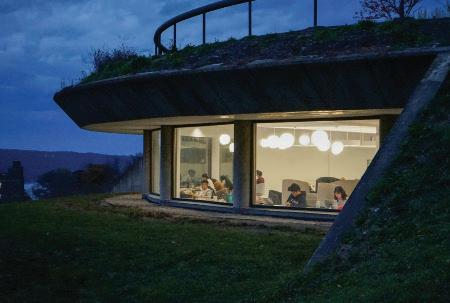

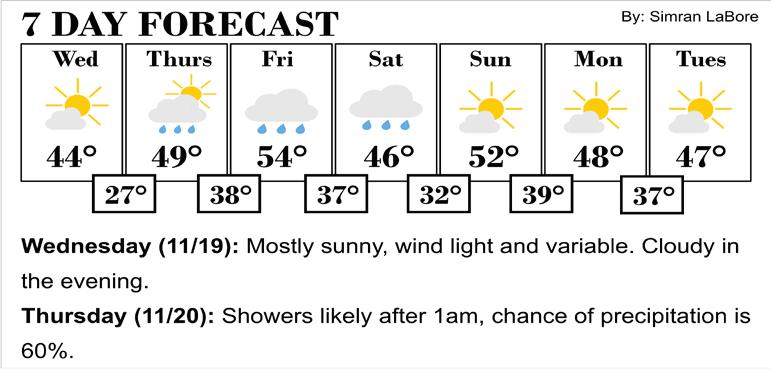




By MATTHEW CHEN Sun Staff Writer
Nov. 17 — During an Oct. 22 Faculty Senate meeting, Provost Kavita Bala addressed what she deemed as “misleading information” surrounding the case that found Eric Cheyfitz, a retired professor in literatures in English, in violation of anti-discrimination law.
“The University normally does not share confidential personnel matters in public,” Bala said. “However, the exception in this case has been made because of the amount of false and misleading information that’s out there that’s created understandable concern and confusion.”
Cheyfitz underwent a discrimination investigation after he allegedly asked an Israeli graduate student in his class to drop his spring course on Gaza, AIIS 3500: Gaza, Indigeneity, Resistance.
Cheyfitz previously told The Sun that the Israeli graduate student’s behavior in class was “disruptive.” According to Bala, the retired professor was set to appear before a faculty review panel on Nov. 3, but accepted a deal to retire before the review, subsequently ending the investigation proceedings.
A Faculty Senate committee, which has jurisdiction under University Policy 6.4, Prohibited Bias, Discrimination, Harassment, and Sexual and Related Misconduct, had ruled in favor of Cheytfitz. However, in light of Cheyfitz’s retirement, the University deferred to
the Cornell Office of Civil Rights’ initial finding of discrimination as the ultimate case outcome.
Why Cheyfitz Asked the Student to Leave Bala noted that in courses on controversial subjects, different opinions will arise, but discomfort with viewpoints cannot be the basis for excluding a student from a course.
“After [the] third class, the faculty member talked to the student and explicitly told the student that he was
doing the readings.”
However, Bala said that in a conversation after class between Cheyfitz and Renard, Cheyfitz told his student that if there was a course that aligned with his views, then he should take it, but Renard did not “have any place” in Cheyfitz’s course on Gaza.
According to Bala, Cheyfitz said to Renard “‘If people want to take a course with your point of view, God bless them, and if there’s a course out there for
the case
did not respond to a request for comment.
Based on this information, Bala said Cheyfitz was charged with discrimination based on nationality and unprofessional conduct based on bias against a student’s presumed view.
“This is not a case of academic freedom,” Bala said. “This is a case of discrimination based on national origin.”
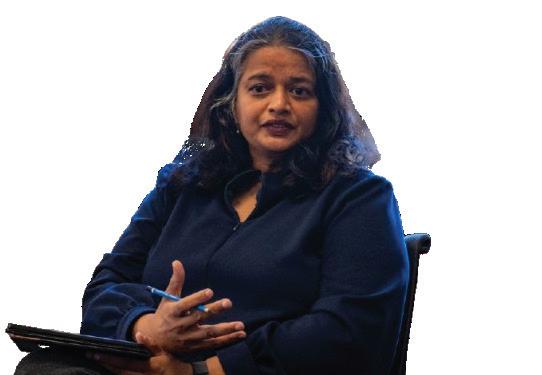
By ARYAN BATADA Sun Contributor
Nov. 17 — Cornell is moving to sell roughly $1 billion in taxable bonds,
as of June 30. On Nov. 7, Cornell reached a settlement with the Trump administration to reinstate approximately $250 million in paused federal research funding. Amidst the funding freeze, which had been
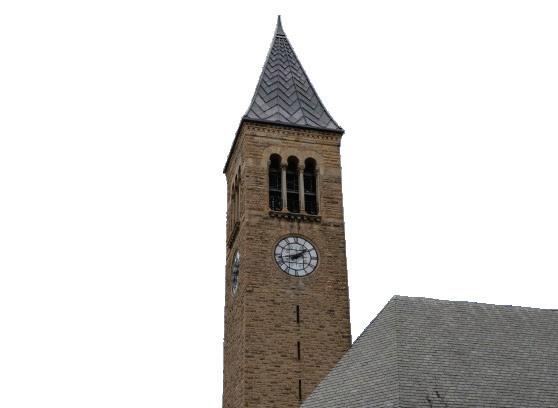
Aryan Batada can be reached at aib49@cornell.edu.
Cheyfitz’s lawyer, Luna Droubi, denied Bala’s statements in an email to The Sun. She refuted that Cheyfitz told Renard to leave his class because Renard was an Israeli student, pointing to the Faculty Senate Committee on Academic Freedom and Professional Status of the Faculty’s determination on the case.
The Faculty Senate Committee on Academic Freedom and Professional Status of the Faculty unanimously found that Cheyfitz had not violated University policy. The ruling determined that Cheyfitz’s comments relating to national origin did not provide sufficient evidence to show that Cheyfitz had asked Renard to drop the course because of his national origin.
Contrary to Bala’s statement, Droubi alleged that Cheyfitz never cut Renard off during their conversation. She wrote instead that Renard “began but did not complete his statements,” and Cheyfitz’s pauses before speaking after Renard were not included in the transcript of the conversation.
By BENJAMIN LEYNSE Sun News Editor
Nov. 15 — When Prof. Gregory Falco, mechanical and aerospace engineering, received a stop-work order last Spring, the word he used to describe the experience was “jarring.” Eight months later, Cornell struck a $60 million deal with the Trump administration to reinstate frozen federal funding — yet Falco’s response was not hopeful.
“It honestly didn’t mean anything,” Falco said in explaining his reaction to the settlement deal.
On Nov. 7, Cornell reached a settlement with the U.S. government to restore all previously paused federal funding. In exchange, the University agreed to pay a $30 million fine to the federal government and invest another $30 million into agriculture research. The settlement also negotiated the closure of several civil rights investigations into the University.
During the months-long pause of approximately $250 million worth of federal funding, the impacts were felt throughout the Cornell community. Since April, over 120 stop work orders — directions from a contracting officer to a contractor to stop all or parts of their research — have halted projects across all
of Cornell’s campuses. These directives have also contributed to the financial insecurity of Cornell, as announced in several University statements made this summer.
In the wake of the settlement, The Sun spoke to students, faculty and alumni to share their perspectives on the deal and reflect on the impact of the lost funding.
Researchers’ Responses For Falco, in the months after his project on the cybersecurity of the semiconductor industry was paused, he says he had to navigate the issue of insufficient funding to pay his lab’s graduate students. Supported in part by a $3 million grant from the Department of Defense, Falco says he was also left wondering what the value of his research was.
“My research — it’s about years of relationships and trust building,” Falco said. “If, you know, money is turned on one day and turned off the next day … this is a signal that our work is not valuable in the way that we thought it was”
To continue reading this article, please visit www.cornellsun.com.
Benjamin Leynse can be reached at bleynse@ cornellsun.com.
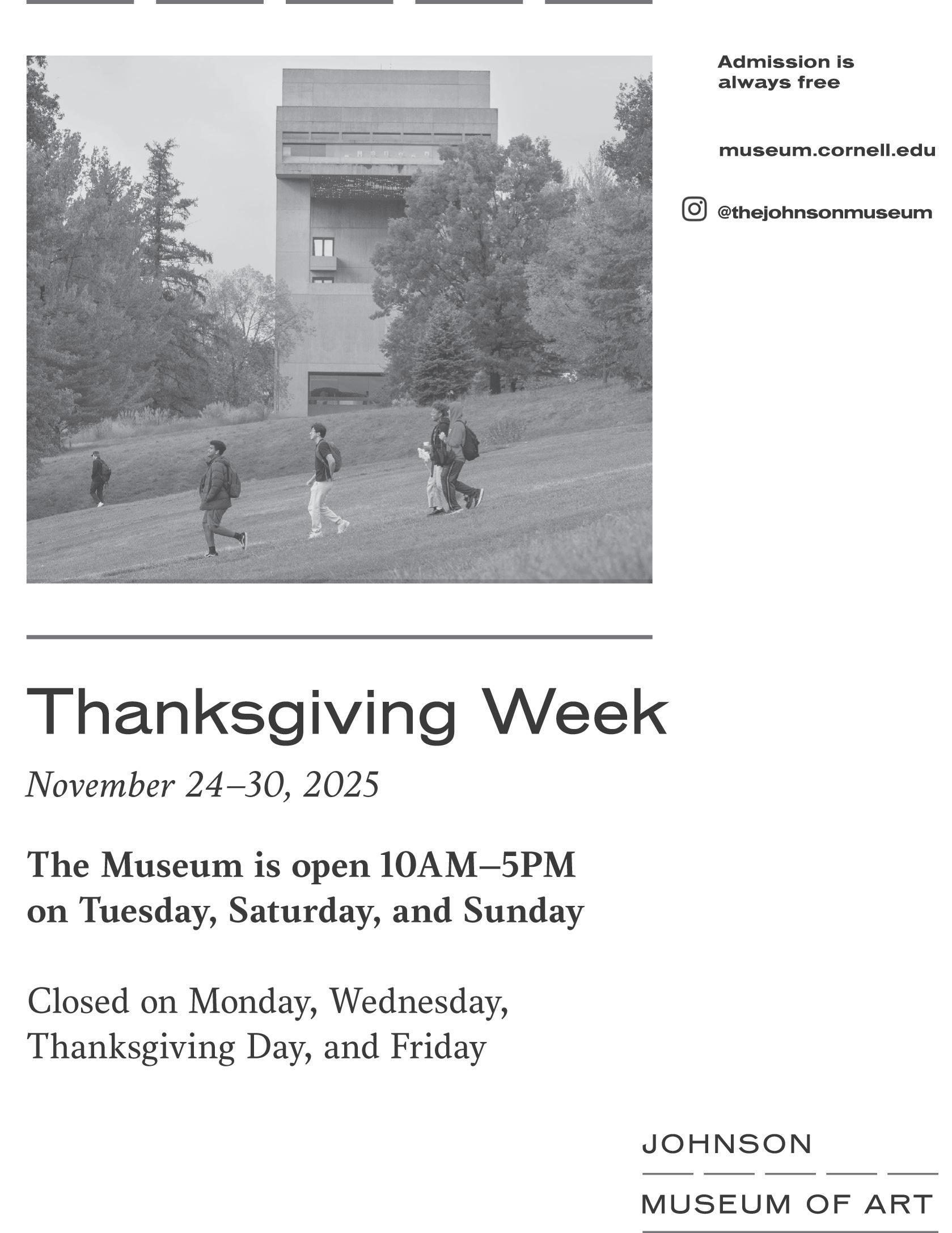
Absolute Zero Open Session with DJ ha-MEEN
3 - 5 p.m., Willard Straight Hall Memorial Room
DICE ePanel: Navigating the Job Market Interviews and Flyouts
3:30 - 4:30 p.m., Martha Van Renssalaer Hall G422
International Research Showcase
4:30 - 6:30 p.m., Atkinson Hall
Girlhood-ish: Unpacking and Dismantling the Adultification of Black Girls 5 - 6:30 p.m., Martha Van Renssalaer Hall 1157
Undergraduate Research Panel 5:30 - 6:30 p.m., Phillips Hall 219

Tomorrow
Japanese Conversation Hour 11 a.m. - Noon, Stimson Hall G25
NeurodiversiTea
Noon - 1:30 p.m., CCC Building 2nd floor atrium
Religious Self Defense 5:30 - 7 p.m., 626 Thurston Avenue LGBTRC Lounge
Free ZUMBA!
6:30 - 7:15 p.m., Noyes Community Recreation Center
A Slice of Self Care 6:30 - 7:30 p.m., Tatkon Center
Stucky Ensemble-in-Residence Splinter Reeds Performance 7:30 - 8:30p.m., Barnes Hall

As
By SUN PHOTOGRAPHY DEPARTMENT

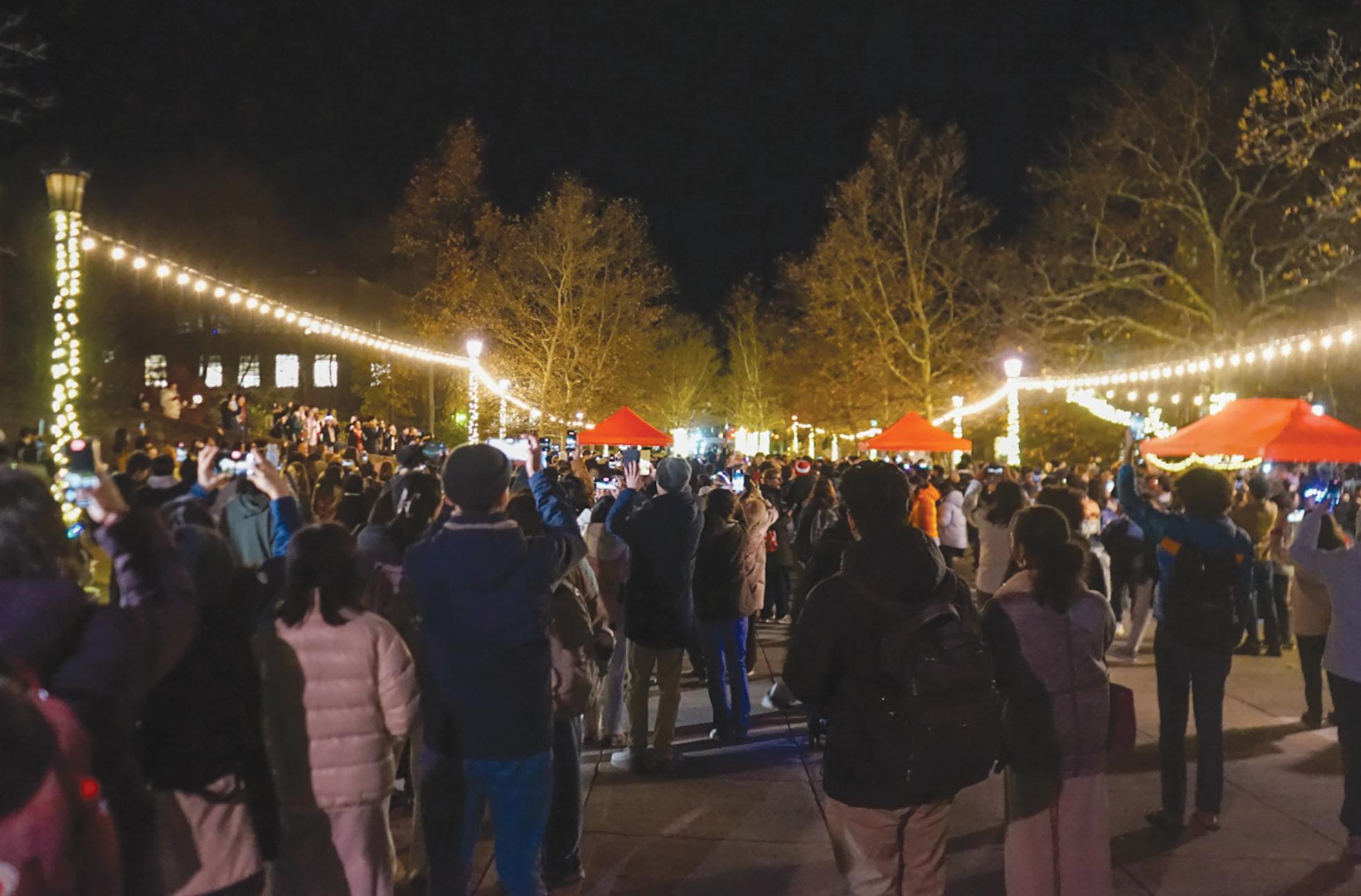
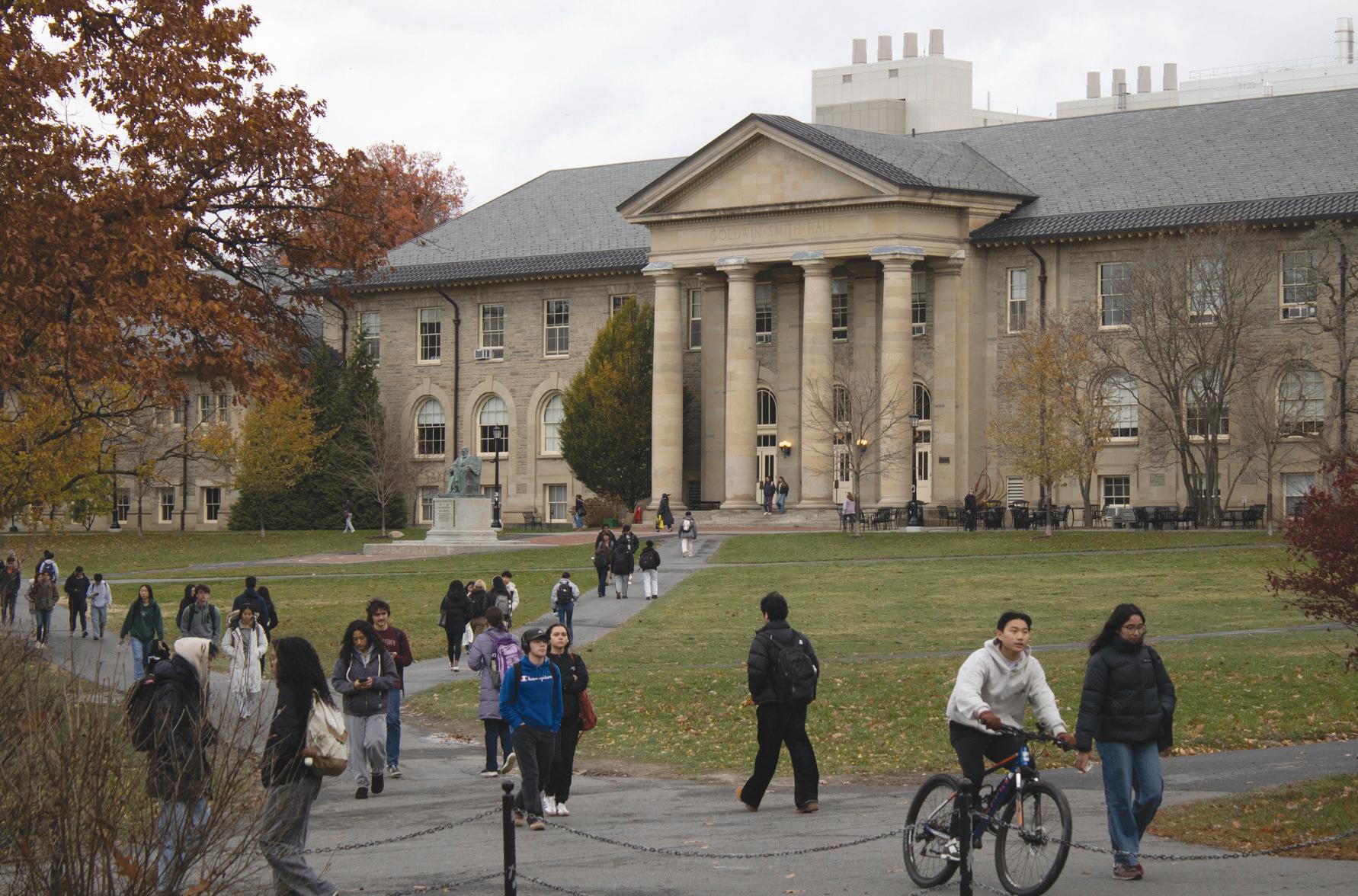
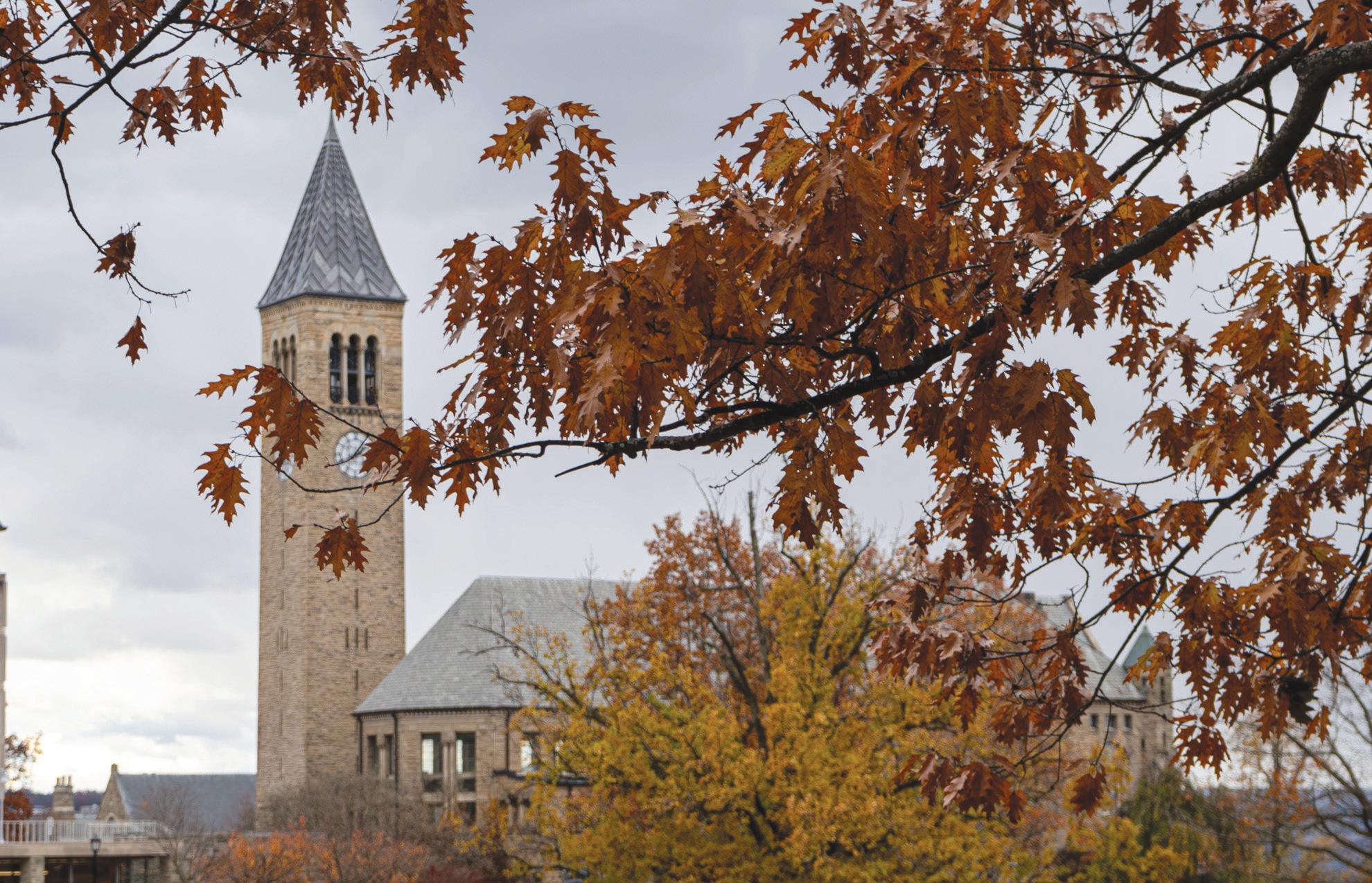
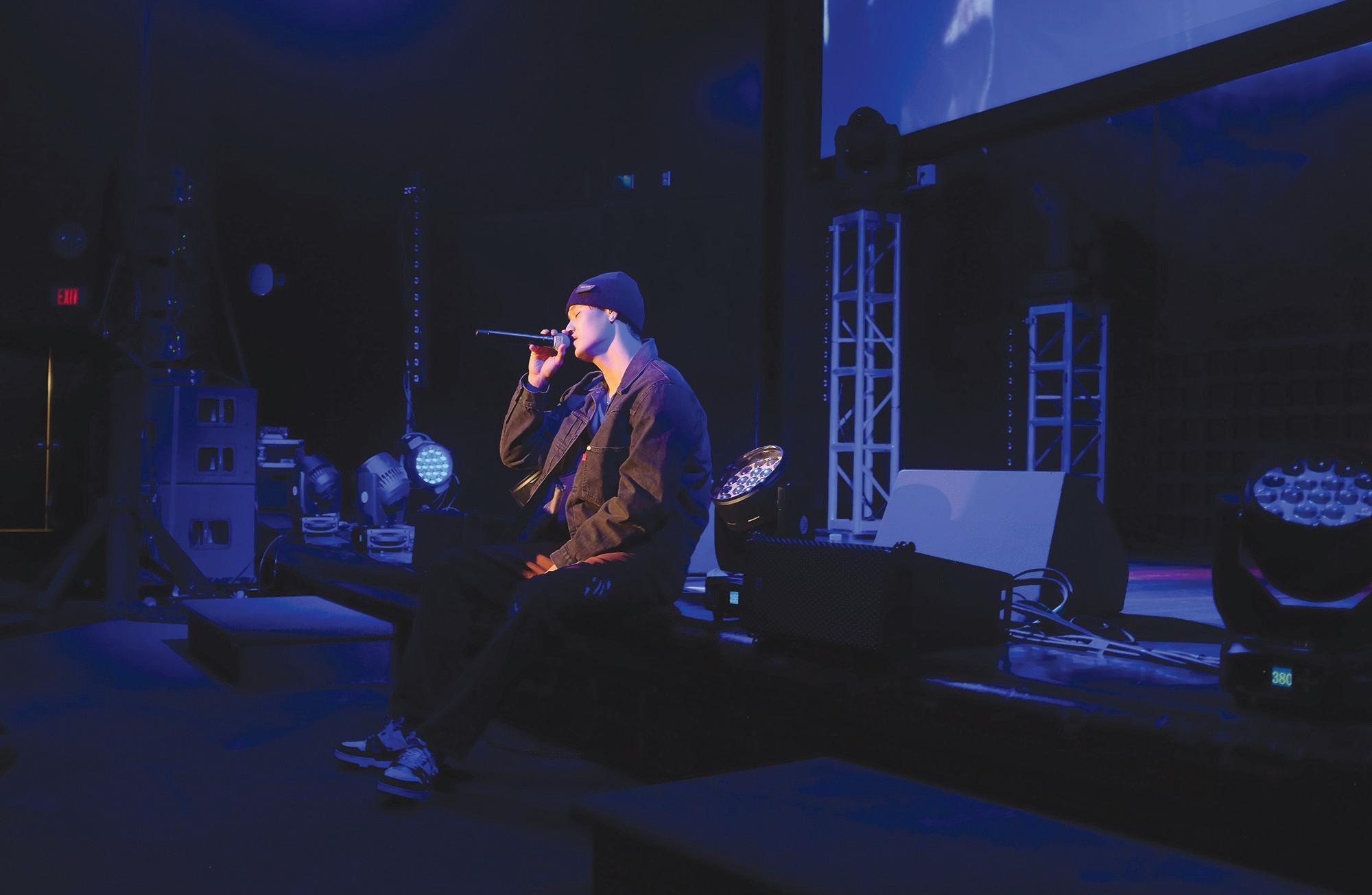
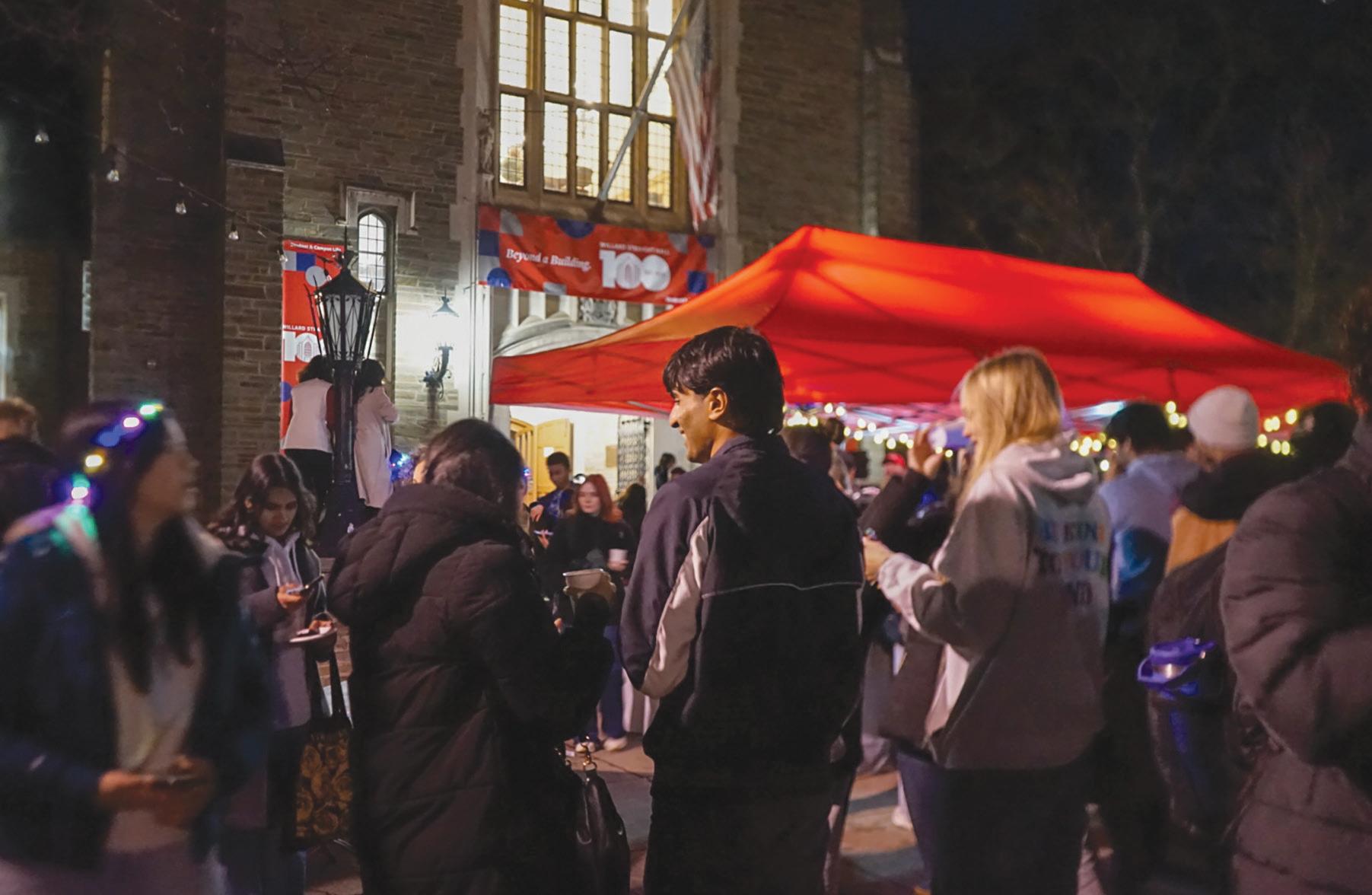
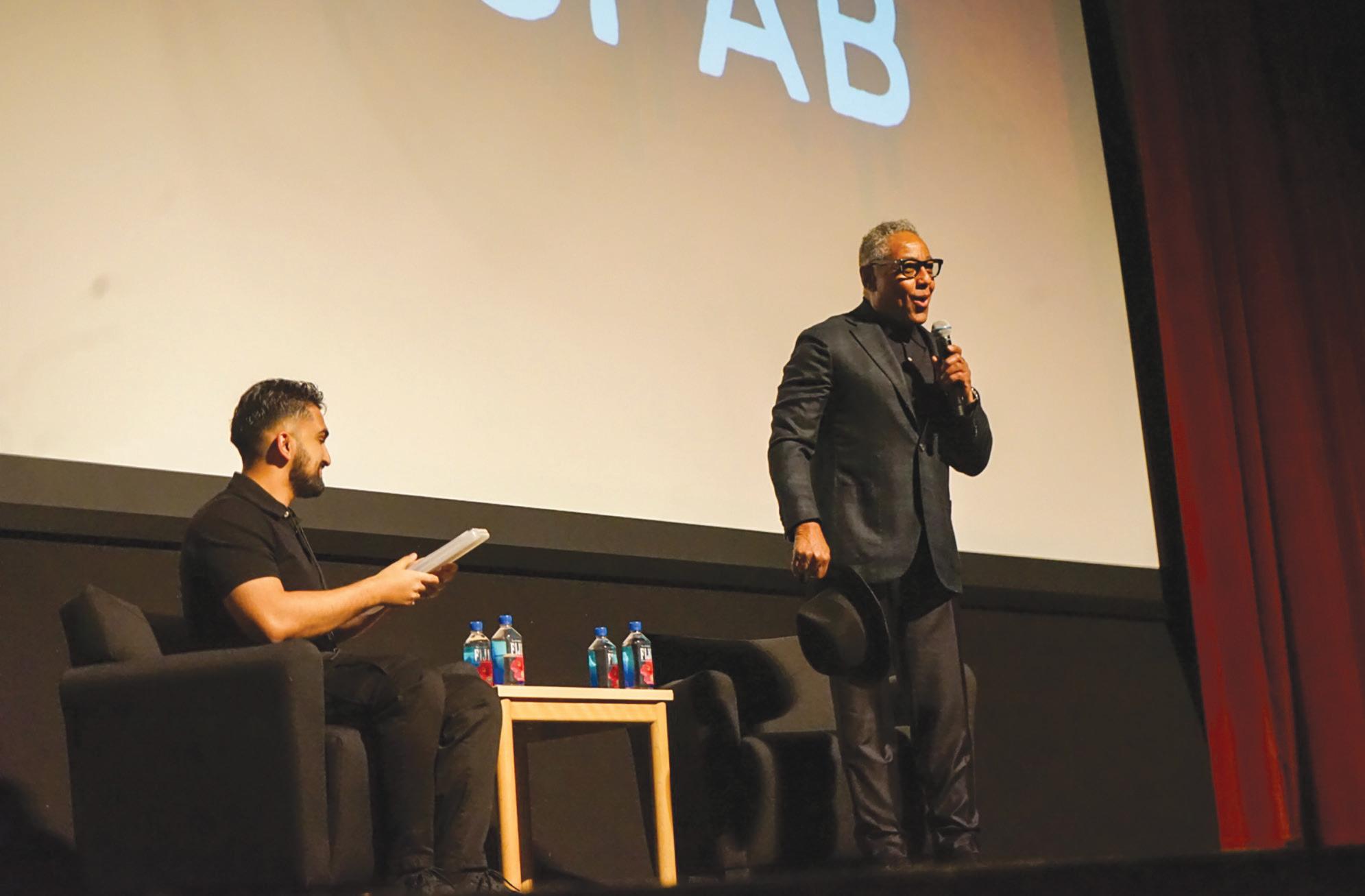
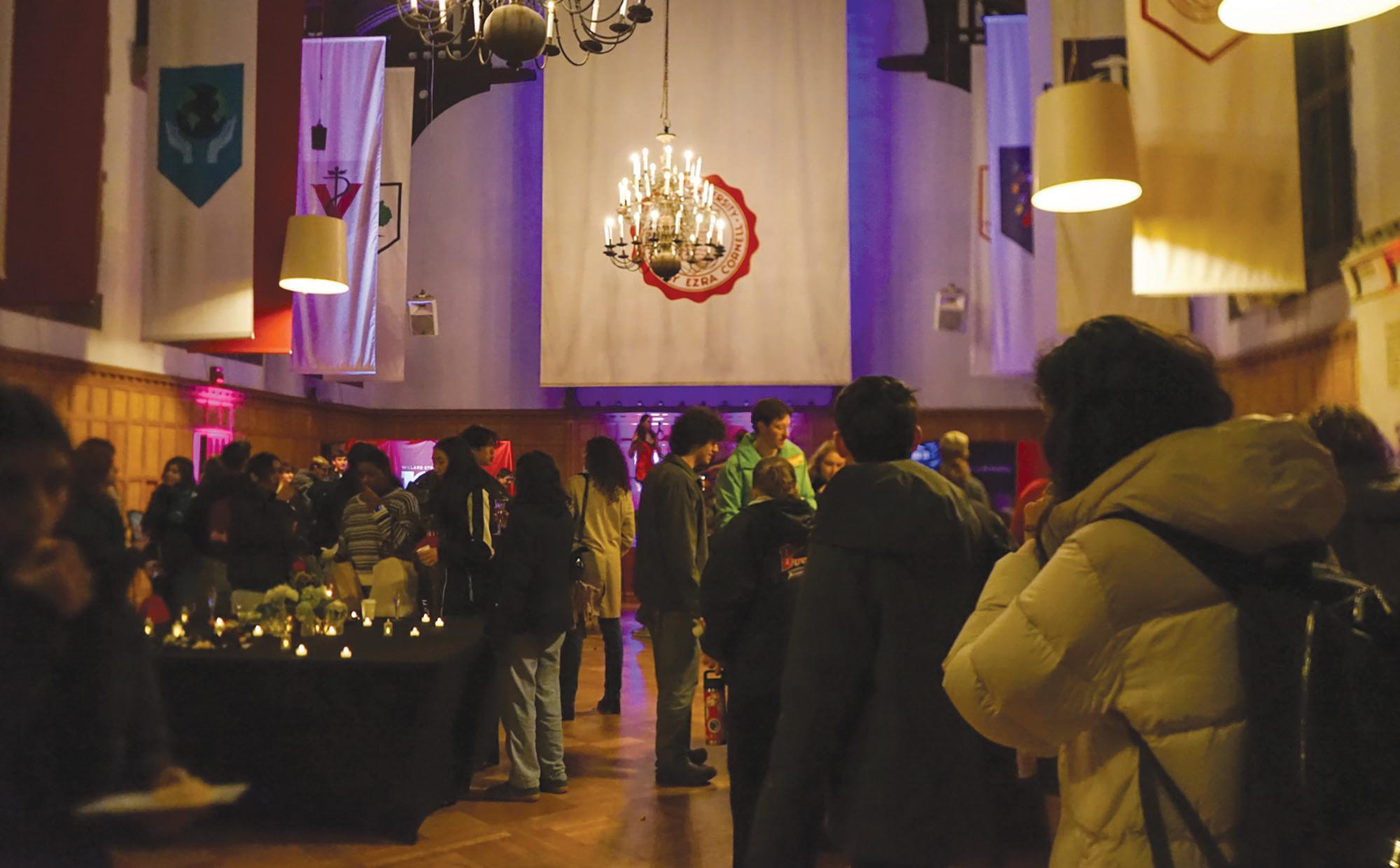
‘A hole in our community’: Students voice concern with Cornell’s support
By MARY CAITLIN CRONIN Sun Staff Writer
Nov. 14 As the Cornell community faces another semester marked by loss, students are critical of the University’s communication and support on campus.
This semester, the University has experienced the deaths of Joselyn Guadalupe Garcia ’29, chemistry and chemical biology department Senior Manager Michael Lenetsky, Prof. Debra Castillo, comparative literature, Thaddeus Lucentini ’29 and graduate student Emily Ryu.
“It left a hole in our community,” said Lara Rodriguez ’29, reflecting on Guadalupe Garcia’s death. Rodriguez lives in the Latino Living Center, where Guadalupe Garcia lived. “It definitely took people being together and supporting each other … there was a vigil for her with candle lights … even now, you still see people leaving flowers.”
Rodriguez said she has been able to find support through communities like the Latino Living Center and the Big Red Marching Band, but was frustrated by the University’s communication in the hours following Guadalupe Garcia’s death.
“The College of Arts and Sciences got an email before the 55 people who live in the Latino Living Center,” she said. “I found out what had happened through Sidechat.”
Césaire Carroll-Domínguez ’28, one of Castillo’s students, learned of his professor’s death in a similar manner. Caroll-Domínguez told The Sun that he found out about Castillo’s death through his peers, who shared screenshots of an email sent to students in the College of Arts and Sciences.
Last fall, the Cornell community was shaken by a series of tragedies that left students questioning the University’s support systems. In
November 2024, the death of freshman Winter Knutson ’27 near Fall Creek Gorge was followed by another student’s hospitalization after a fall in the same area, a drugging and sexual assault report at the Chi Phi Fraternity house that led to its suspension and the charging of a Cornell custodian in a homicide off-campus.
The University response to these November 2024 tragedies included an email from Ryan Lombardi, Vice President of Student and Campus Life, urging students to “lean on each other and show support, empathy and care to each other.”
This year, administration did not send a campuswide email about tragedies on campus until Ryu’s death, the fifth Cornell death since the beginning of the semester.
“In moments like this, when it may feel like our campus light is diminished, it is critical to take a moment to pause and reflect on the things that matter most — the community we create together and the opportunities for connection that surround us,” Lombardi and Christine Lovely, vice president and chief human resources officer, wrote in the email.
Brayden Handwerger ’27, a transfer student, said that Cornell often focuses on short-term solutions rather than addressing “core problems” like academic and career pressure.
“The school has done a lot to give students resources to talk about why they’re mentally unwell,” Handwerger said, citing academic, career and social stress. “But it has not necessarily done enough to ask why students are unwell.”
He called the University’s “work hard, play hard” attitude a “dangerous culture” that leads to students developing unhealthy coping mechanisms to manage their stress during the week.
“[Students face a] tremendous amount of pressure in terms of academics, in terms of their
career, and in terms of just the general social culture of comparison,” Handwerger said. “[It] leads to people to do way too much on the weekends as a sort of means of overcompensating for how stressed out they are during their regular lives.”
Some students hope to address the gaps they see in the University’s support services.
Carroll-Domínguez said the University should do more to help students manage stress before they reach the point of coping in harmful ways, and that he became an orientation leader for the College of Architecture, Art, and Planning to help do that.
“I think that a part of preparing students for college, generally, is teaching them methods for coping with anxiety and depression and learning how to talk about these things,” he said. “It’s tough to transition to college, and there’s not enough support for incoming students to learn how to cope because it’s so different being away from home.”
Nambita Sahai ’27, the co-president of EARS, a student-run peer support organization that provides drop-in mentoring and workshops across campus, said that she has seen an increase in students seeking support this semester.
“It’s very important to be okay with more uncomfortable, sort of deeper emotions,” Sahai said. “Simply validating someone’s experiences can be so transformative.”
EARS focuses on empathy and active listening while working with peers, Sahai said. Peer connection during stressful times is also a very important part of the organization’s work, she added.
“Peers are some of the first people that people come to when they are stressed, when they’re feeling down,” Sahai said. “Having greater knowledge about how to support your fellow peers is super important, especially in

stressful times like right now.”
Cornell’s first priority in times of tragedy “is caring for the people most directly affected and ensuring that support is available to anyone who needs it,” a University spokesperson wrote in a statement to The Sun.
“Our approach is both grounded in personal connection and is data informed,” the spokesperson wrote. “We rely on our direct relationships with campus communities, communication, and collaboration to make sure that no one is left to navigate grief or loss alone.”
As students reflected on the pressures they face and the support they hope to see strengthened, many have said the challenges of this semester have underscored what they believe Cornell must prioritize going forward.
“Cornell is an incredible place with an incredible standard that creates incredible students and workers,” Handwerger said. “However, this can’t be done at the cost of human life.”
Individuals can have a diverse range of feelings, needs and reactions when facing loss. This information about Grief and Loss may be helpful to you or a friend. The Ithaca-based crisisline can be reached at 607-272-1616, and the 988 Suicide & Crisis Lifeline is available throughout the U.S. Additional support resources are listed at mentalhealth.cornell.edu.
Students in need of professional support can email Student Support and Advocacy Services at studentsupport@cornell.edu or call Counseling and Psychological Services at 607-255-5155. Employees can call the Faculty and Staff Assistance Program at 607-255-2673.
Mary Caitlin Cronin can be reached at mcronin@cornellsun.com.
CHEYFITZ
Continued from page 1
Nov. 17 — Droubi emphasized that many of the statements Bala made were selected phrases from a transcript of a “secretly recorded” tape that Renard took during his conversation with Cheyfitz — something she said Cheyfitz was not aware of throughout the meeting. Droubi wrote that it was an “unauthenticated tape,” and noted that Cheyfitz had previously raised questions regarding the credibility and reliability of the recording from the start of his disciplinary proceedings.
“[Renard] was well-qualified to manipulate the conversation to his advantage,” Droubi wrote. “The student subsequently refused to hand over the audio file to investigators, instead requiring them to rely on a transcript for the investigation.”
When asked if he only submitted a transcript of the recording and about Droubi’s allegation that he was “well-qualifed” to manipulate that transcript, Renard did not respond to a request for comment.
Renard is a Ph.D. candidate focusing on computer theory. According to reporting by The Nation about his LinkedIn profile, he previously served in Israel’s elite military surveillance agency, Unit 8200. His LinkedIn profile no longer includes his time in Unit 8200, but it includes other cybersecurity work he did with the Israeli Defense Forces. Renard’s In-Class Behavior
Bala also addressed the narrative surrounding the student’s “disruptive” behavior, saying that Renard had attended three classes in total and,
according to Cheyfitz, was silent in the first, spoke briefly in the second and spoke for less than two minutes in the third.
Bala said that at the start of the third class, Cheyfitz asked to speak with Renard after class. In that conversation, Bala said “[Cheyfitz] explicitly told the student that I, quote, ‘think your conduct in the class has been fine so far, so I’m not complaining about you.’”
According to Bala, in Cornell’s Office of Civil Rights’ investigative interview with Cheyfitz, he said Renard was “‘respectful in his responses.’” When questioned about Renard’s engagement in class, Bala, quoting Cheyfitz, said, “‘As I remember, [Renard] responded a few times to what the students were saying for all I know. Again. I wasn’t paying strict attention to him.’”
Droubi wrote that Cheyfitz maintained, even before his decision to ask Renard to leave his class, that Renard was “disruptive to the learning environment” in class.
“The rest of Professor Cheyfitz’s testimony — which Provost Bala did not release — makes clear that Cheyfitz did believe the student to be disruptive,” Droubi said. “Provost Bala continues to twist and take a few words out of context, going so far as to breach confidentiality of a closed matter simply to try and justify the administration’s conduct.”
To continue reading this article, please visit www.cornellsun.com.
Matthew Chen can be reached at mchen@cornellsun.com.
By MAYA BRENER Sun Contributor
Nov. 13 — The Student Assembly approved several of the Finance Committee’s funding recommendations at its Thursday meeting, including allocations for ALANA Intercultural Board, CUTonight, the Community Partnership Funding Board and the Interfaith Council at Cornell, while voting to eliminate Empathy, Assistance & Referral Service’s direct funding and move the group under the Student Activities Funding Commission.
The Assembly also heard a presentation from the Presidential Task Force on Institutional Voice and considered resolutions regarding Special Projects funding, which included pushback during public comment and from Assembly members.
Members also announced upcoming meetings with the Gender Justice Advocacy Coalition on Sunday at 10 a.m., followed by a 12:30 p.m. meeting with Class Councils. This follows a rejection of the Finance Committee’s original recommendations to reduce funding for these groups at the Nov. 6 Assembly meeting after an hour of heated public comment and controversy during the Oct. 30 meeting.
Student Trustee Keten Abebe ’27 and Assembly President Zora DeRham ’27 also announced that they will host a town hall next Wednesday, with details posted on Instagram.
Byline Organization Funding
As several organizations have engaged in back-and-forth rapport with the Assembly, Thursday’s meeting led to closure on many financial cases.
The Assembly unanimously approved the Finance Committee’s recommendation to increase ALANA’s funding by 12.9 percent, following backlash to their initial recommended decrease.
Vice President of Finance Hayden Watkins ’28 explained that the committee initially recommended a decrease, believing ALANA sub-organizations could be funded by the SAFC. However, he later discovered they already were, but were still experiencing insufficient funds.
The Assembly also approved the Finance Committee’s recommendation to reduce CUTonight’s funding to $11 per student, an 8.3 percent decrease from the last cycle. The organization had requested a 50 percent increase — one of the largest requested increases among applicants.
Finance Committee members said CUTonight failed to demonstrate a need for the dramatic increase. The committee noted that although CUTonight reported being unable to fund four Spring 2025 events due to insufficient funds, the organization still funded 71 events.
To continue reading this article, please visit www.cornellsun. com.
Maya Brener can be reached at mb2929@cornell.edu.
By SHANNON LIN Sun Contributor
Nov. 18 — The Center for Transformative Action has entered a new, unfunded affiliation with Entrepreneurship at Cornell, following the University’s decision to phase out more than $100,000 of its annual funding by 2027.
CTA — the parent organization of many on-campus initiatives, including Anabel’s Grocery, Durland Alternatives Library and Prisoner Express — had previously been in a 53-year affiliation with Cornell United Religious Work, a multifaith community comprising over 40 religious and spiritual leaders. In February 2025, Dean of Students Marla Love, told The Sun that CTA’s subsidiary agencies have “outgrown the intent” of its original affiliation agreement, leading to its loss of funding and transfer to EaC.
“Born from the turmoil of the late 1960’s at Cornell,” the CTA was created at a time when many chaplains within CURW took part in anti-war and civil rights protests, according to
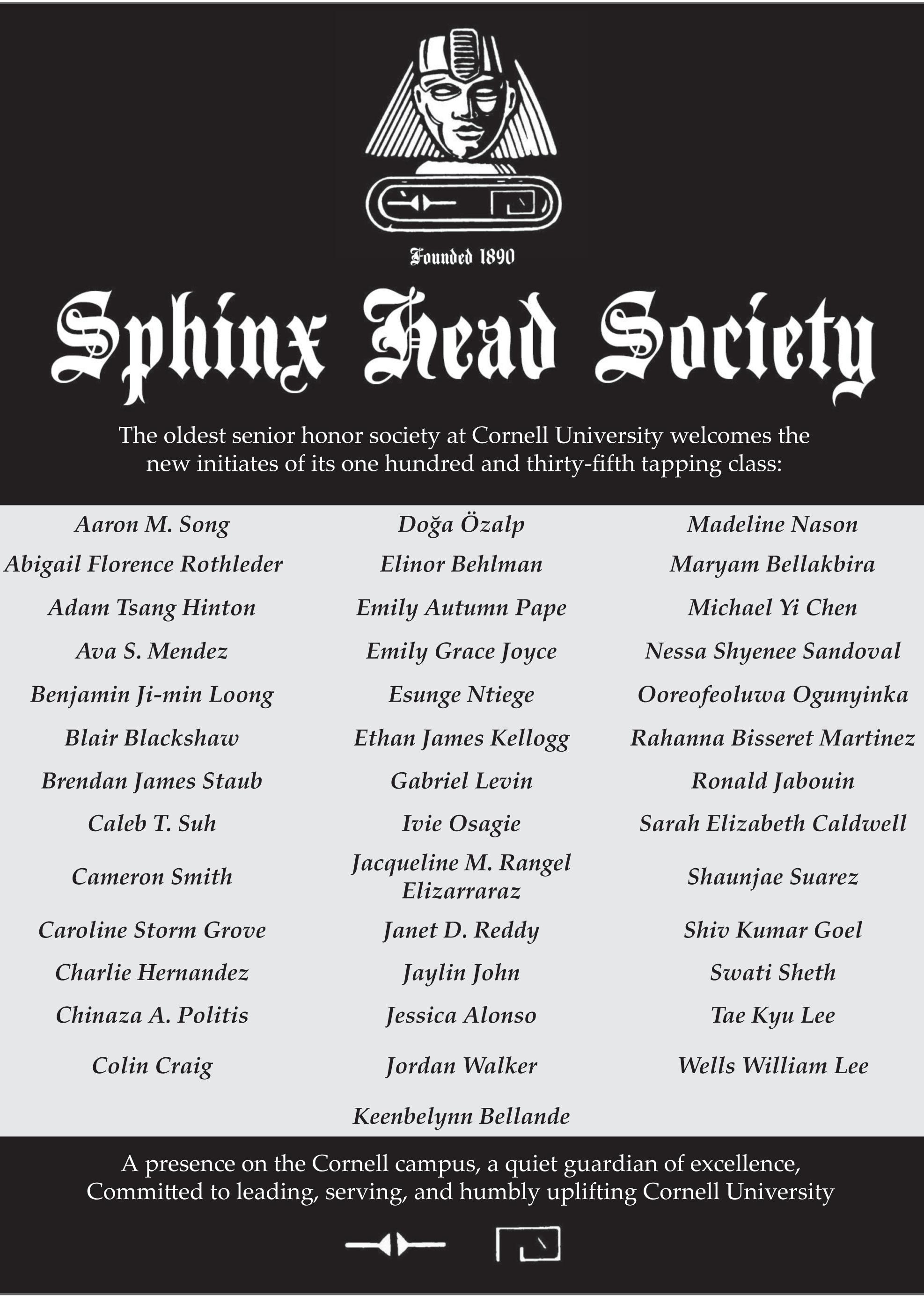
the CTA website. In 1971, the Cornell Board of Trustees moved “to house these activities within a newly incorporated, education-based center, one that was affiliated with, but legally separate from, Cornell.”
As the fiscal sponsor of 40 nonprofit organizations based on Cornell’s campus and beyond, CTA Executive Director Anke Wessels described the organization’s new position at Cornell.
“While many universities have incubators for for-profit entrepreneurs, Cornell is the only major university affiliated with a nonprofit incubator and fiscal sponsor,” Wessels wrote in a statement to The Sun.
Wessels added that while “establishing a nonprofit venture is daunting,” CTA’s aim is to help faculty, staff, students and community turn their “transformative ideas into nonprofit initiatives.”
To continue reading this article, please visit www.cornellsun.com.
Shannon Lin can be reached at sl3454@cornell.edu.
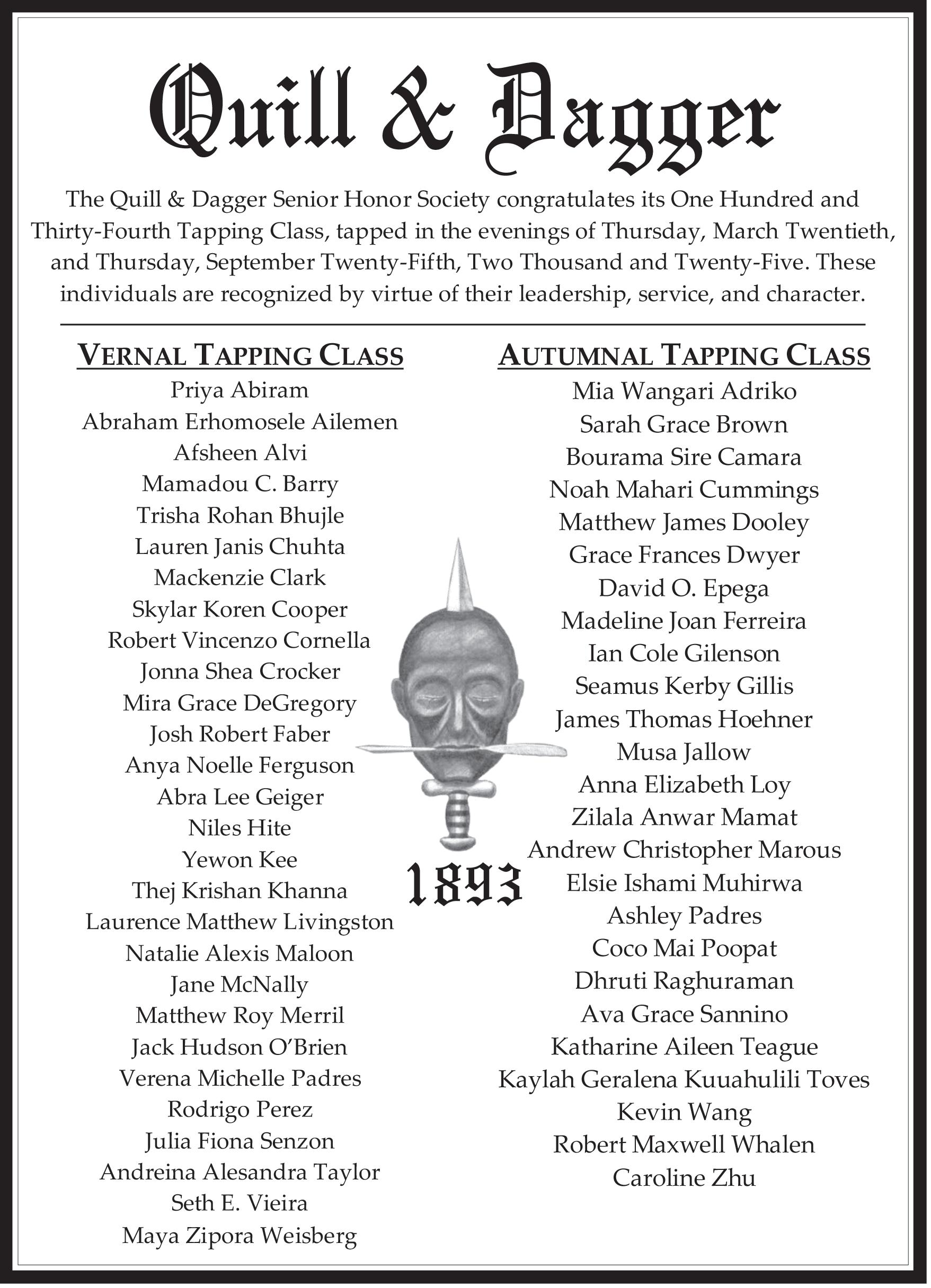
JULIA SENZON ’26
Editor in Chief
ERIC HAN ’26
Associate Editor
SOPHIA DASSER ’28
Opinion Editor
SOPHIA TORRES ’26
Advertising Manager
SYDNEY LEVINTON ’27
Arts & Culture Editor
JAMES PALM ’27
Assistant Arts & Culture Editor
JENNA LEDLEY ’27
Assistant Arts & Culture Editor
MELISSA MOON ’28
Assistant Arts & Culture Editor
SOPHIA ROMANOV IMBER ’28
Assistant Arts & Culture Editor
KAITLYN BELL ’28
Lifestyle Editor
MAIA MEHRING ’27
Lifestyle Editor
KARLIE MCGANN ’27
Photography Editor
MATTHEW KORNICZKY ’28
Assistant Photography Editor
STEPHAN MENASCHE ’28
Assistant Photography Editor
MIRELLA BERKOWITZ ’27
Video Editor
JADE DUBUCHE ’27
Multimedia Editor
HANNIA AREVALO ’27
Graphics Editor
HUNTER PETMECKY ’28
Layout Editor
RENA GEULA ’28
Layout Editor
CHRISTOPHER WALKER ’26
Games Editor
ALLISON HECHT ’26
Newsletter Editor
DOROTHY FRANCE-MILLER ’27
Managing Editor
MATTHEW KIVIAT ’27
Assistant Managing Editor
VERA SUN ’27
Business Manager
ALEX LIEW ’27
Human Resources Manager
BENJAMIN LEYNSE ’27
News Editor
VARSHA BHARGAVA ’27
News Editor
ISABELLA HANSON ’27
News Editor
CEREESE QUSBA ’27
News Editor
REEM NASRALLAH ’28
Assistant News Editor
ANGELINA TANG ’28
Assistant News Editor
KATE TURK ’27
Assistant News Editor
GABRIEL MUÑOZ ’26
City Editor
JANE HAVILAND ’28
Features Editor
ZEINAB FARAJ ’28
Features Editor
JEREMIAH JUNG ’28
Assistant News Editor
KAITLIN CHUNG ’26
Science Editor
MARISSA GAUT ’27
Science Editor
ALEXIS ROGERS ’28
Sports Editor
MATTHEW LEONARD ’28
Assistant Sports Editor
SIMRAN LABORE ’27
Weather Editor
Te Cornell Chapter of the American Association of University Professors represents faculty, academic staf and research employees with the goal of advancing academic freedom and shared governance. David Bateman, one co-author of this column, is a professor of government. He can be reached at dab465@cornell.edu.
The animating principle of the draft report on institutional voice is that there needs to be greater clarity about who speaks for the University and when the University can speak. As the committee chairs have made clear, “institutional voice” only concerns speech on behalf of the University as a corporate body.
Where the report stays focused on this principle, it is generally quite strong.
For starters, the committee should be commended for using the language of restraint rather than neutrality. Restraint suggests that the University should be prudent in speaking, and should thoughtfully consider its speech acts. It also allows that at times the University must speak forcefully. By contrast, the idea of institutional neutrality has generally proven to be unclear and unhelpful. Given the University’s inevitable entanglements, entailments, and effects in the world, it can never be a neutral institution. Arguments for “neutrality” obscure what is an ongoing political choice over the set of issues upon which the University will be silent and those upon which it cannot, and wrongly imply that this choice can be determined a priori, almost mechanically.
Institutional restraint much more accurately recognizes that while a general set of principles about when the University ought to speak can be described in advance, this can only guide the decision, which will inevitably involve disagreement and so require judgement. Even if we could agree about “core values” and the “core mission” — which, despite the report’s suggestion, cannot be boxed off in a footnote — we cannot prescribe when or how these will map on to political or
Te Committee on the Future of the American University is a group of 18 faculty appointed by the provost to explore how the university can evolve to best serve future generations while pursuing its core mission of education, scholarship, public impact and community engagement. Te committee welcomes ideas and feedback at fau@cornell.edu.
Higher education in America today faces an unprecedented set of challenges. But perhaps no crisis facing universities is more consequential than the loss of public trust.
Recent survey data indicate a broad decline in trust that extends across ideological and demographic lines. A 2023 Gallup poll found that only 36 percent of Americans express a great deal or quite a lot of confidence in higher education — a substantial drop from 48 percent just seven years prior. That number did recover slightly in a 2025 survey, rising to 42 percent.
One reason often cited for the decline is financial: escalating tuition costs, coupled with a perceived decline in the economic value of an undergraduate degree, have led many to question the return on investment in higher education. Another concern is ideological. Accusations of bias have eroded confidence in the ability of universities to foster open inquiry and promote academic freedom as a collective good, rather than a means to promote a single point of view.
These concerns have been exacerbated by policy controversies around high visibility issues such as COVID-19 vaccines and the factors contributing to climate change. Federal agencies have also raised concerns about scientific integrity.
All this feeds into the broader crisis of confidence in universities, a crisis that mirrors nationwide decline in trust across American institutions, including government, media and industry. New technologies such as AI bots and deepfakes erode authenticity and challenge the discriminating power of critical thought and cultivated expertise. Meanwhile, political polarization, powered by a media environment that rewards outrage, reframes difference and disagreement as implacable division.
As a result, our vision of the future can become occluded by the fear and vulnerability shaping the present, which engender distrust. Trust-building under such conditions faces strong headwinds. Yet working to build trust now can also constitute a powerful countervailing force to the proliferation of distrust in its refusal to forsake goodwill. Consequently, it is critical that we understand what we mean by trust and what is at stake in reestablishing American faith in higher education.
airplanes, we are trusting university-educated physicists; when we take medications, we are trusting university-based biomedical research. Almost every institution of American society — industry, media, government — relies upon the trustworthiness of university research and education to clearly define challenges, innovate solutions and explore new ideas. Trust in American society has become inextricably interwoven with trust in universities.
So, what can we do? The Committee on the Future of the American University is eager to engage with voices from across the Cornell community to develop new approaches to bolster public trust.
One lesson we have learned already is that public trust in higher education is symbiotic with trust within the university. “On campus” and “off campus” are closely intertwined, especially in the age of social media. What happens in one reverberates instantaneously in the other. Building trust on campus has tremendous power to reverberate far beyond.
A second lesson is that public engagement is vital but requires attention. Over the last decade, Cornell engagement with community groups and public stakeholders has increased dramatically. Yet, despite this effort, public trust more broadly has diminished. So how can we do better?
Third, trust takes time and a willingness to share. Robust networks of trust emerge from a shared set of understandings, common goals, mutual interests and, importantly, a collective image of the future. None of these demand agreement or homogeneity, but they do require sustained discussion.
The crisis of trust facing American higher education presents a critical challenge. This moment of reckoning is an opportunity to reaffirm the university’s indispensable role in a democratic society. As institutions dedicated to inquiry, education and the public good, universities are not merely recipients of trust; they are the essential producers of the very conditions that make societal trust possible — from scientific knowledge to a citizenry capable of civil discourse.
other controversies requiring University speech or counseling silence.
The report also usefully clarifies that only the University president and provost speak for the University as a corporate body (with some inevitable complications about the latter’s role given that we are blessed with two provosts). There is some ambiguity insofar as the report seems to suggest — but statements by the committee co-chairs in the University Assembly contradict — that the Board of Trustees also speaks for the University. That ambiguity is easily resolved by amendments clarifying that only the president and provost speak for the University as a corporate body.
The report rightly recognizes that, like much else at the University, institutional restraint is a principle that should be tightly binding at the top but loosen very quickly as you move down the organizational hierarchy. By the time it gets to units, centers and departments, individual faculty and students, it is — or ought to be, by the terms of the report — irrelevant. Speech by a department, or by a student organization, is not institutional voice, which only concerns speech on behalf of the University as a corporate body, which only the president and provosts are authorized to do.
The report, however, goes on to specify conditions under which other individuals or units below the president or provost can speak. Here the report introduces unnecessary confusion and begins to intrude on academic freedom and shared governance.
To continue reading, please visit www.cornellsun.com.
Trust describes an implicit disposition of goodwill that allows communities to work effectively toward common ends, cooperate despite uncertainty and promote a general sense of security amongst community members.
The research and training conducted at universities establish the background conditions of trust that makes everyday life possible. When we drive over bridges, we are trusting civil engineers trained at universities; when we board
The task ahead is immense, but the goal is clear: to embrace the profound potential of a revitalized American university dedicated to strengthening the foundational capacity for trust that sustains our mission and American society itself.
Signed,
Adam T. Smith
Co-Chair of the Committee on the Future of the American University Distinguished Professor of Arts and Sciences in Anthropology
Karim-Aly Kassam is an opinion columnist and professor in the Department of Natural Resources and the Environment as well as the American Indian and Indigenous Studies Program. His column Diference Matters recenters critical refection and environmental justice in campus life at a time when people turn away from the painful truth. He can be reached at profkkassam@cornellsun.com.
In our classes we are observing substantive levels of mental health concerns among students. One does not need a medical degree to understand these pressures result in other physical manifestations of ill health. There is a higher level of uncertainty and stress in students’ lives now. Yet, the challenges students face are understandable in our current political, social and ecological context. If they did not feel anxiety and deep concern, then we, as an educational institution, should be worried. Whether they are in the biological, physical and social sciences or the humanities, we teach our students: “Once you know, you become responsible.” We commit them to responsible action resulting from their education. Engineers make an even more explicit commitment to this principle. They take an oath: “As an Engineer, I pledge to … [be] conscious always that my skill carries with it the obligation to serve humanity by making the best use of the Earth’s precious wealth. … When needed, my
skill and knowledge shall be given without reservation for the public good.” In a ceremony, a ring is, then, placed on an engineer’s finger as a reminder of the solemn vow.
We urge our students to commit to a cause greater than themselves. Urging them not to exist in a narcissistic, self-centered universe but to situate their understanding in a universe-centered self. Yet today our students find themselves in a period of cognitive dissonance. While we teach that knowledge is embedded with responsibility, their leaders, mentors and even parents act irresponsibly or, worse, remain silent in the face of clear and evident injustices: the climate crisis, biodiversity loss and a myriad of violence on living beings and the planet itself. What is witnessed by our youth cannot be denied by their elders, no matter how inconvenient.
To continue reading, please visit www.cornellsun.com.

Yihun Stith '26 is an opinion columnist studying computer science and government in the College of Arts & Sciences. His fortnightly column, Stand Up, Fight Back, explores the political structures and power dynamics that shape life at Cornell. Trough analysis, critique and calls to action, the column challenges Cornellians to engage with the world beyond the campus bubble and to fght for a more just and accountable university. He can be reached at ystith@cornellsun.com.
In an age dominated by situationships, Cornell has taken the bold step of making its love afair with the Trump administration ofcial. On Friday, Nov. 7, Cornell announced an agreement with the Trump administration to restore Cornell’s federal research funding. And just like marriage, Cornell’s relationship with Trump is all the more meaningful because it is now contractual. Trump managed to extract $60 million from the University, a payout some might dismiss as unfortunate but ultimately irrelevant because the deal does not dramatically alter Cornell’s culture.
In the mere 15-minute “town hall” following the deal, President Michael Kotlikof echoed that sentiment. “Nothing in this agreement afects our academic curriculum, free speech on campus,” he said. “Tose were the issues we were most intent on resolving.” However, Kotlikof, you gave up on free speech and academic integrity long before this deal. Your administration coerced a pro-Palestinian professor into retirement, attempted to slyly change the Student Code of Conduct to sideline our institution’s shared governance branches and fostered an unsafe environment for non-citizen students. Tis agreement is no “compromise.” It is nothing more than Cornell committing to its lover. Trump’s love language is words of afrmation, and Kotlikof clearly learned how to keep him satisfed.
Of all of the Ivies that have settled, Columbia walked away with the worst deal. One of its most damning concessions is its decision to change its protest rules and pro-
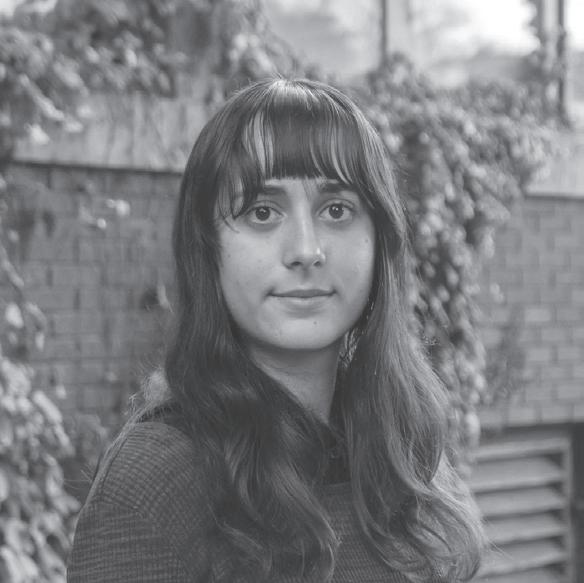
Mina Petrova '29 is an opinion columnist studying English, history and government in the College of Arts & Sciences. Her fortnightly column North Star studies the past and critiques the present, focusing on politics, protests and activism that strive toward a more equitable future. She can be reached at mpetrova@cornellsun.com.
It’s Tuesday, Nov. 4: Election Day 2025. Te day began with the death of Dick Cheney and ended with the election of Democrats and Democratic Socialists all over the country.
I grew up in Astoria, Queens — the heart of the NYC Democratic Socialists of America with Tifany Cabán, Zohran Mamdani and Alexandra OcasioCortez as my DSA-endorsed representatives. Ever since the Democratic primary, I had been counting down the months, days and, by 8:59 p.m., the seconds until New York City would elect a Democratic Socialist as our mayor.
At the same time as Zohran Mamdani’s campaign, here in Ithaca, Cornell’s chapter of YDSA was organizing to elect Hannah Shvets ’27 — the youngest successful candidate endorsed by DSA — for Ward 5 Common Council.
Tis election cycle yielded incredible news for leftists all around the country. In New York City, Mamdani won with over 50 percent of the vote. Kelsea Bond became the frst Democratic Socialist to be elected in Atlanta, winning over 64 percent of the vote. It was a victory for Democrats as well, with decisive wins for governors in Virginia and New Jersey, managing to fip a signifcant number of Republican voters. Here in Ithaca, DSA-endorsed candidates Jorge DeFendini and Hannah Shvets won seats in the Ithaca Common Council.
vide the federal government with information on internal disciplinary actions involving student visa holders when requested. Unlike Columbia, it seems that Cornell has put up an ostensible boundary in our relationship with Trump. Our agreement with the Trump administration makes no agreement to provide the federal government with extra data on our international students. However, should we be so confdent in our university?
In May, international graduate student Amandla Tomas-Johnson received notifcation that his immigration status had been terminated by the federal government, presumably for his alleged participation in the Palestine liberation protests. Te following day, he received a notifcation from Google that his email had been subpoenaed by the Department of Homeland Security. However, Google’s policies state that, for accounts managed by organizations — like our Cornell email accounts — only the organization's administrators are notifed of subpoena requests. Yet, when pressed if Cornell had received a request from DHS to subpoena Tomas-Johnson’s account, Cornell declined to respond to both Tomas-Johnson and Te Sun.
If Cornell did not provide the federal government access to students’ emails, then why not deny the accusation? When you pair that vulnerability with Cornell’s expanding surveillance apparatus, the comfort evaporates quickly.
Updates to Policy 8.1 quietly mandated that “all cameras (including academic and research) must be integrated into the university’s centralized security video surveillance system.” In an environment where Cornell refuses to confrm or deny whether the Department of Homeland Security has subpoenaed students' email accounts over protest, how are students supposed to trust Cornell not to hand over surveillance footage to Trump? You may think this threat of surveillance does not apply to you — that, as someone who has committed no crime, you are insulated from state scrutiny. But recall that the Trump administration has already detained international students for nothing more than writing op-eds calling for divestment and opposing Israel’s genocide. Tis administration has shown no regard for legal limits, only for the political value of intimidation.
So when Cornell refuses to clarify whether it cooperates with federal investigations into student activism, the burden shifts entirely to the University — not students — to demonstrate that the international community is protected rather than merely permitted to exist. So far, there is little evidence of that protection.
And the Cheyftz case makes clear that this atmosphere of fear is not limited to non-citizens. In fact, it exposes just how far Cornell is willing to go to avoid popping up on Trump’s radar. Cornell’s administration alleges that pro-Palestinian Professor Eric Cheyftz told Israeli graduate student Oren Renard to drop his course because the student was Israeli. However, the Faculty Senate Committee on Academic Freedom unanimously found that Cheyftz had not violated University policy. Furthermore, the central administration's witch hunt was based upon an unofcial transcript that details a conversation Renard secretly recorded between him and Cheyftz. However, the raw audio seemingly was never provided during the investigation. Renard previously worked for Unit 8200, an elite cybersecurity unit in the Israeli Occupational Forces, raising concerns that he could easily manipulate the transcript and audio.
Additionally, the majority of the other students in the class with Renard believed he “had come [to class] to disrupt.” Tey were worried they “were being recorded” by Rennard and fearful it would later be used to dox them. Rennard's actions even led a Palestinian student to drop the course.
Instead of retreating, Cornell’s central administration unilaterally escalated the situation under the pretext of “following federally required law.” By ignoring the ruling of the academic freedom committee and pressing forward with possibly fabricated evidence, the administration signaled that they will go to great lengths to preemptively appease the federal government. Te decision to punish Cheyftz was not merely about legality. Instead, the decision was political. Prior to this case, Kotlikof had made his discontent with Cheyftz’s pro-Palestinian stance known. Kotlikof had called Cheyftz’s Gaza course description “radical, factually inaccurate, and biased” in an email to a professor.
In its pursuit of a Jewish professor teaching a course on Gaza, Cornell mirrored the tactic that Trump used to extort Cornell: treat criticism of Israel as discrimination and use the language of civil rights to punish views the institution fnds inconvenient. If this is what happens to a tenured professor cleared by his peers, the message to the rest of campus is unmistakable: Te content of your scholarship is undeniably infuenced by the federal government.
Te fate of our “academic curriculum” and “free speech” does not need to be written in a contract. Teir fate is decided by the actions of our University. And so far, those actions paint a worrying picture.
For the frst time, there was something that I was excited to vote for in US politics. As a nine-year-old, I rode the tide of Bernie Sanders enthusiasm, yelling out “Feel the Bern” with my parents at political rallies — the only time I have ever attended them. After that, it was disappointment after disappointment with Trump’s frst far-right candidacy and disillusionment over Biden’s support of Israel in its genocide of the Palestinian people. With the Harris and Trump electoral race, my choice was between a center-right and far-right candidate.
Compared to the international political spectrum, United States politics is skewed to the right. Our “leftwing” representatives, the Democratic Party, are, to borrow from folk musician Phill Ochs, “ten degrees to the left of center in good times [and] ten degrees to the right of center if it afects them personally.” In the frst 2024 election debate, Kamala Harris afrmed that she was pro-military, pro-fracking and against gun control. “Radical” Democratic Socialists such as Mamdani, who Republicans have branded as “communist extremists,” base their platform on policies taken for granted in most European countries. Abroad, free public transit, universal childcare and rent freezes are programs of common sense and empathy.
Yet, Mamdani’s victory proved that grassroots organizing can triumph over oligarchy. Andrew Cuomo’s campaign raked in $55 million from a handful of power brokers, calculating to $65 a vote. A large sum went into an Islamophobic smear campaign featuring racist AI-generated ads, including one infamous video depicting an AI-generated Mamdani eating with his hands and a Black man wearing a kefyeh and shoplifting.
Zohran’s campaign, on the other hand, was powered by over 100,000 unpaid volunteers. Daily, people knocked on doors, called voters and organized within their communities. Every time I went back home, I would spot “Vote for Zohran” messages written on the sidewalk in chalk.
It was the same story for Hannah Shvets’ campaign ever since she narrowly won her primary against landlord and former factory CEO, G.P. Zurenda. After losing to Shvets, Zurenda then proceeded to pull an Andrew Cuomo by running as an independent in the general election. Like Cuomo, a small number of big corporations and property owners paid large sums of money to his campaign. Zurenda averaged $362 per donor while Shvets averaged $15.64 from 448 contributors.
In an interview with me, Shvets’ campaign reported
that volunteers knocked on 2,479 houses, registered close to 200 students to vote, tabled outside for weeks, assembled scores of buttons and made 3,670 phone calls. All this was organized by students who have their hands full with classwork in one of the most elite universities in the nation. “I think just being present around campus this month helped a lot,” said Shvets in the interview. “We got to know so many people and told them about the race, how to vote and why it's so important for Cornell students to engage in local politics.”
Hannah Shvets won with a staggering margin of 243 to 134 in an election with historic voter turnout. In NYC, we saw the greatest number of voters in half a century. Tese elections demonstrate the formidable strength of grassroots organizing. Tat’s certainly not a new revelation, but it needs to be said. It needs to be yelled out from rooftops and spread from city to city. Most importantly, it needs to continue to ensure that our elected Democratic Socialists can fulfll their promises.
Although I believe that capitalism must ultimately be replaced for true liberation, these electoral wins matter right now. Rent stabilization, free child care and higher minimum wages can alleviate the symptoms of oppression and have the capacity to help millions — indisputably, an incredible victory. “We can mobilize people around these issues,” Shvets said. “Coming to public comment at City Hall, writing letters to Cornell, holding rallies, etc., are all things that go into getting meaningful legislation passed.”
But the fght is not over. Te forces of oligarchy and fascism — through real east lobbies, police unions, billionaire donors, AIPAC and conservative media ecosystems — are prepared to smother these victories. Tey will spend billions to undermine our elected Democratic Socialists, starve them of resources, and then proclaim that “once again, socialism failed.”
Tis is why the work after election day is even more important. Te real power gained from organizing to elect Mamdani, Shvets and many more, is the momentum that comes from learning how to mobilize renters, students and the community. Electoral politics will not guarantee us a new world, but these wins open up a small crack in the current system. And historically, from these cracks slip through revolutions. As Mamdani said in his victory speech, quoting Eugene Debs, “I can see the dawn of a better day for humanity.” As the Red Sun Rises on this new dawn, it is up to us to make sure it reaches its zenith in the sky.

By RACHEL HORN Sun Contributor
Deep within the brainstem is a structure no bigger than a grain of rice, the locus coeruleus. The LC is often referred to as the “blue spot” because of a distinct blue pigment produced from its inner synthesis reactions.
Despite its microscopic size — 2 millimiters x 12 millimeters — the LC is central to memory and the production of norepinephrine, a neural signaling molecule essential to the response to stress.
The LC nerve cells are capable of changing the brain's level of alertness and arousal, attention, learning and memory. The LC transmits signals that mark a piece of information as meaningful so that it can be recalled. This complex also helps us react to external stimuli, reevaluate our surroundings and plan new courses of action.
Despite the fact that the LC is frequently dismissed by standard biology textbooks, research associate Elizabeth Riley, psychology, a member of the Affect and Cognition Lab, explains that this region is quite ancient, dating all the way back in the family tree of life.
“When we think about cognition and human brain diseases, we often think about parts of the brain that are newer or more specialized in humans —that's not the case here,” Riley said.
Another leading explanation for the underappreciation of the LC is that it is difficult to study the phenotypes produced by specific lesions in the brain stem because any damage often proves fatal.
“It took a long time to understand how
these tiny brain stem structures that are so ancient and deep in the brain are actually having a profound effect on our behavior," said Riley.
Indeed, researchers have only recently begun to appreciate how critical and vulnerable this tiny structure is. The LC system's correlation to Alzheimer’s is associated with the complex’s initial deterioration and worsening as the disease progresses. Alzheimer’s is a brain disorder with loss of memory, thinking, and reasoning that interferes with daily life.
The LC is among the first regions of the brain to fall victim to Alzheimer’s-like changes at 20 or 30 years of age. Furthermore, death of nerve cells in the LC can be used to track the severity and progression of the onset of Alzheimer's.
However, this tiny region is difficult to image. Structural MRI techniques allow researchers to capture a picture of the places in the brain full of neuromelanin, a metabolism waste product of the synthesis of norepinephrine. This neuromelanin builds up throughout an individual’s lifespan, from the generation of dopamine and norepinephrine.
“We don’t quite fully understand yet how this technique works. We can take a picture of the two brain regions that have neuromelanin in them, which includes the locus coeruleus,” Riley said.
However, there has been the rise of promising interventions to help maintain LC function with aging. Vagus nerve stimulation is a technique that delivers an electrical current through the skin at points where the vagus nerve, which transmits signals for involuntary movement, lies closest to the skin. Its name
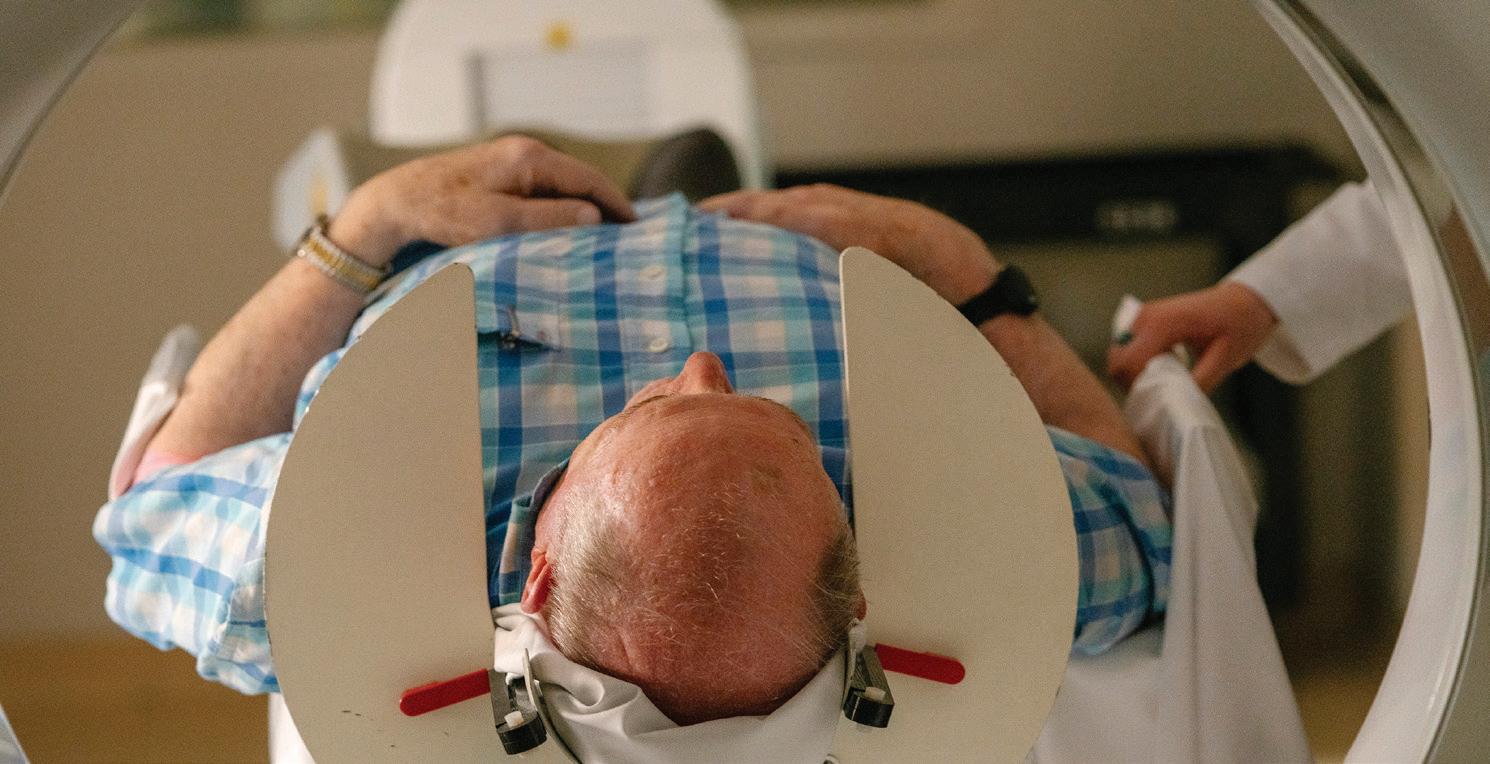
comes from the Latin word “vagus,” meaning “wanderer,” reflecting the nerve’s extensive reach throughout the torso of the body.
“The vagus nerve takes all the information from your gut and your heart, and all kinds of other places, and it brings it up to your brain. On the way up to the brain, we can deliver stimulation,” Riley said. “Stimulating the vagus nerve is one step away from stimulating the locus coeruleus. So we can modulate how the LC is working with vagus nerve stimulation.”
This might reveal that this form of stimulation might improve the LC’s functioning in older adults and improve symptoms of Alzheimer’s disease.
Furthermore, Riley points to music’s “magical power” in neurodegenerative disorders, where familiar songs can help patients
“wake up.” She wonders whether the LC might underlie this intriguing effect.
Music modulates human emotions and the LC is a central player in shaping our affective state. Heightened LC activity, with its surge in norepinephrine production, often accompanies stress. Relaxation, on the other hand, reflects a strong parasympathetic tone.
Acting like a “thermostat,” the LC integrates signals from across the brain to adjust norepinephrine levels. When music allows us to relax, part of that response is expressed through the LC.
Moving forward, Riley hopes to integrate music into her future research, exploring whether musical engagement itself helps preserve LC function as we age.
Rachel Horn can be reached at rsh273@cornell.edu.
By TANIA HAO Sun Staff Writer
Now in its sixth year, the Cornell project team CU GeoData bridges engineering and earth sciences to design and deploy environmental sensors, including a sensor network across the Finger Lakes and a specialized weather balloon for atmospheric research. Through these projects, the team hopes to make data more accessible to local communities and contribute to research on environmental change.
GeoData is divided into five subteams — the Air, Rock, Water, Data and Tech teams — that collaborate to design sensors and instrumentation to collect environmental data under the project team’s shared tagline “Design, Build, Deploy.”
“There is a lot of focus when it comes to building models and stuff that the
Ithaca community can use,” said Orion Hoch ’28, GeoData’s current secondary lead and Water Team lead. “But realistically, a lot of our work is just in providing as much as we can to the research field.” The Water Team leads water quality assessment, water resource management, and related projects.
As an engineering project team in the earth and atmospheric sciences department, GeoData brings together students from computer science, engineering and earth and atmospheric sciences, providing a unique interdisciplinary approach. These diverse perspectives have helped GeoData take on projects from both a research and product development perspective, according to Kylie Miller ’26, current primary lead of GeoData and former air team lead.
“[For] a lot of people, instead of

designing their own stuff, they'll order it and then focus on the data,” Miller said. “But since we have electrical engineers, mechanical engineers, chemical engineers, everybody's taking their expertise and then focusing on what they can develop.”
According to Nour Kastoun ’26, former primary lead of GeoData and current senior advisor, the team hopes to move towards more team-wide projects that integrate the strengths of each subteam. “It's cool because we all have different strengths,” she said. “And we're all interested and passionate in bringing all of our different strengths together to solve relevant problems.”
Currently, GeoData is focusing on an ambitious project to develop a sensor network around Cayuga Lake that will deploy air, water and soil sensors at thirteen proposed or existing sensor sites around the lake.
The team has already deployed some soil moisture sensors and weather stations at locations including the Cayuga Nature Center and Cornell Sailing Center. They also plan to install a weather station at the Montezuma National Wildlife Refuge, located at the north end of Cayuga Lake. For future installations, the team is developing a 3-D printed weather station that will be less expensive to produce than commercially purchased models.
The sensor network aims to fill a gap in the available earth and climate data of the Ithaca region. Soil moisture and air quality sensor networks around Cayuga Lake are minimal and infrequently maintained. Weather forecasts in Ithaca are
primarily sourced from a national weather service center in Binghamton, which can decrease the accuracy of weather forecasts, according to Miller.
Using the sensor data, GeoData hopes to create improved forecasts and environmental models that are accessible by the local community. Previous data that the team has collected is stored on the Network for Environment and Weather Applications, a database run by Cornell and various regional environmental organizations. However, the team is developing a new website to collate air, soil and water data that they hope will be more accessible to the public as a single hub for environmental data.
The air team also hopes to connect their weather data to Weather Underground, a commercial weather service that provides real-time weather information and forecasts, with the intent of improving the quality of weather forecasts in Ithaca.
Ultimately, the goal of the sensor network is “having more local weather stations and data [and] being able to provide that, free of charge, to agricultural professionals and farmers, so that they can actually make better informed decisions about when to plant, when to harvest,” Kastoun said.
Hoch emphasized the importance of this type of sensor data for understanding environmental change.
To continue reading this article, please visit www.cornellsun.com.
Tania Hao can be reached at ts936@cornell.edu.
By Katelyn Halverson
Katelyn Halverson is a sophomore in the School of Industrial and Labor Relations. She can be reached at kh874@cornell.edu.
By nature of Cornell’s vast, and tragically hilly, campus, Cornellians hardly have to struggle to achieve their daily 10,000 steps — making it all the more appealing to skip the gym. When the walk to and from your dorm leaves you in a state of caffeine-wired exhaustion, it’s unsurprising how easy it can be to neglect your fitness goals. After all, why waste precious time on the stairmaster after grappling with the wrath of gravity on Libe Slope?
I’d argue that prioritizing exercise, although inconvenient at times, is especially beneficial for college students. Choosing fun, energizing workouts can break up the monotony of busy days, develop our self confidence, and carve out a sense of community here on campus. There is perhaps no better place to pursue these goals than alongside friends and classmates at Cornell’s own group fitness classes. Conveniently spread across North and West Campus, Noyes, Teagle Hall, Helen Newman and Appel Fitness Centers collectively offer a broad selection of workouts, from Cycling to Bare to HITT — all taught by kind and knowledgeable instructors. Having attended a number of these classes throughout the semester, I’ve compiled a few key takeaways from each that just might inspire you to attend!
Barre
Legend has it that “Cornell Calves” are built like steel, but this barre class casually disproves the myth within the first ten minutes. Barre targets select muscle groups using a combination of small, isometric movements, a rotation of three- to five-pound weights and an exercise ball. This class is vaguely reminiscent of the introductory ballet classes you may have taken as a child, only combined with the fiery muscle burn of pilates. I’ve taken barre with two different instructors, both of whom were excellent at offering corrections on form. Perhaps the best part about these classes, other than the expertly crafted playlists, is that it is adaptable to any skill level — just ask the lovely senior ladies I’ve seen at every class!
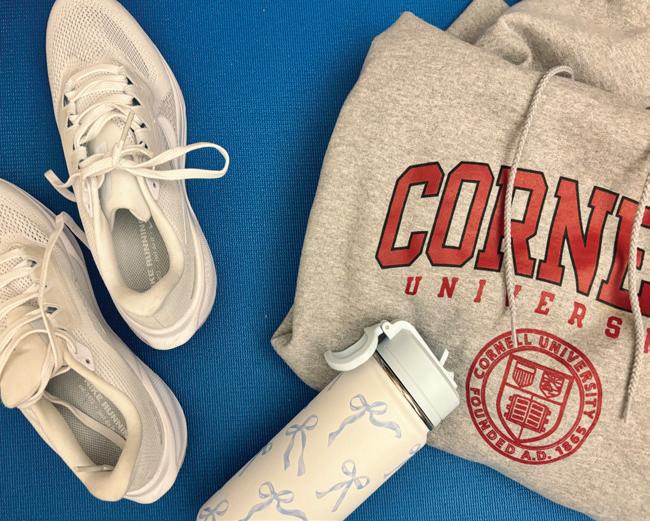
If you love cardio-heavy workouts with a little bit of chaos, you’ll love zumba. Our fitness centers offer both traditional and toning classes, but I personally prefer the latter for its emphasis on weight training. Regardless, expect to have both your heart rate and dopamine levels raised. For readers who might be unfamiliar with the practice, zumba is a beginner-friendly, high energy dance class fueled by blasting Latin music and contagiously positive vibes. I am slightly embarrassed to admit that I seem to fall somewhere below beginner status, as I endured a significant hit to my ego trying (and failing) to keep up with the instructor for the full hour. But then again, being terrible at zumba might just be half the fun — call it the karaoke of fitness, if you will.


By Maya Rothbard
Maya Rothbard is a sophomore in the College of Arts and Sciences. She can be reached at msr295@cornell.edu.
Yoga
On those days when it feels as though you’ve been operating on autopilot, thoughtlessly orbiting from classes to club meetings, yoga is ideal for practicing intentional mindfulness. Luckily, there is no shortage of options to choose from: offerings include, but are not limited to, “Slow and Intentional Yoga,” “Yoga with Meditation and Breathwork,” “Rockin Yoga,” as well as Vinyasa, Kripalu and Ashtanga-inspired flows. In my experience, Vinyasa might be the best starting point for beginners. None of the sessions I’ve attended are anywhere near as intimidating as strength- or cardio-focused classes, but it is perfectly normal to experience some discomfort as you become familiar with a new type of movement. All of the yoga instructors I’ve encountered are extremely welcoming to newcomers, offering clear instructions while encouraging each person to take the class at their own pace. As a side note: I’ve noticed many of these sessions tend to fill up quickly, so get there early if you want to score a spot up front!
HITT / Core Power
It was during this workout that I learned just how humbling 45 minutes and a pair of eight-pound weights can be. I can feel the soreness returning to my muscles simply recalling the sets involving a resistance band. This bootcamp-style workout may be a tad intense for some, but it also has a refreshing atmosphere of encouragement. I was particularly thankful for the instructor, who always came through with a much-needed push to help me get through those final reps. Having survived to tell the tale, I can attest that the feeling of accomplishment you walk out with makes all of the struggle (and the sweat) worthwhile.
Cycling
Cycling classes are a weirdly polarizing niche within the fitness bubble: you may try a class once and vow to never return, or end up developing a personality-consuming obsession around it. Although I definitely align more closely with the first category, I will contend that this class would easily hook a dedicated Peloton fan. The 2010s pop playlist kept everyone happily head-bobbing, while the instructor maintained a smooth, unstressful flow. It didn’t quite have the same intensity of an actual Peloton class, but I was certainly not complaining.
Pilates
Similar to Barre, pilates is a perfect blend of low impact, high intensity exercise. Pilates classes are intentionally slower in pace, with a heightened emphasis on breathing, control and, above all else, form. These classes generally utilize some combination of an exercise ball, a resistance band and a light set of weights. The overall vibe is consistently light and relaxing throughout,while the workout itself presents an enjoyable challenge. I think it’s safe to say the self-proclaimed “pilates girls” of the internet would enthusiastically approve.
I hope you consider this guide a small, but worthy, introduction to the thriving world of Cornell fitness. If none of these options interest you, classes such as TRX Fusion or CU Row could also be worth investigating. (They were not included among this list simply because I have yet to attend!) There is a spot for everyone in this wonderfully inclusive fitness community, so don’t hesitate to lace up your sneakers and invite a friend — your new favorite workout is waiting!
Haveyou ever finished dinner and suddenly been hit with an undeniable craving for something sweet? The kind of craving that can only be cured by ice cream, cookies or something equally indulgent? Then, real- ity sets in — you don’t have a car, and the thought of trek- king across town for dessert feels impossible. Don’t worry, though. Ithaca has plenty of sugar fixes within reach, and this guide will show you exact- ly where to go when your sweet tooth strikes (with no wheels required).
First stop: Frozen yogurt at Jason’s. This spot tops my list, conveniently nes- tled in the heart of Collegetown and just a short walk away, especially for engineers wrap- ping up at Duffield or Hotelies finishing a long day at Statler, since the location is practically made for a post-class treat. If anyone is a fan of frozen yogurt like I am, Jason’s won’t disappoint you. I usually get the birthday cake, chocolate and vanilla flavors topped with strawberries, chocolate chips, rainbow sprinkles, oreo pieces, cookie dough and M&M’s. (Yes, I’m fully aware that’s a chaotic combo, but trust me, it works.)
The best part about Jason’s is the freedom to customize. Whether you’re in the mood for something fruity and refreshing or rich and choco- latey, the topping bar gives you endless ways to experiment. The atmosphere is relaxed, as you’ll often see students laughing over their creations or scrolling through assignments as they take a study break. The staff are always friendly and quick, and the space feels like one of those quintessential Collegetown gems where time slows down, just enough for you to enjoy your dessert. If you’re lucky, you might even snag an indoor window seat near the frozen yogurt dis- pensers. There are, however, some seats where you can sit outdoors, but let’s be real: who wants to sit outside holding ice cream in the freezing Ithaca weather that we are now experiencing?
Next, we have Insomnia Cookies, which I’m sure a lot of you are familiar with. Insomnia, hence the name, is open until 3 a.m., making it a great place to grab a late-night treat after studying, hanging out with friends or even just satisfying a sudden cookie craving. Their warm, freshly baked cookies and variety of flavors make it perfect for any- one looking for a sweet treat at anyWhilehour. Insomnia is known for their cookies, they also serve brownies, blondies and ice cream. Everything at this location in Collegetown, a short walk away from Central Campus (like Jason’s), is baked fresh daily, ensuring that each treat is warm, gooey and packed with flavor. Whether you’re stopping by for a clas- sic chocolate chip cookie or indulging in a decadent ice cream brownie combo, Insomnia Cookies has something to satisfy every late-night craving. The cozy, casual vibe of the store also makes it a great place to hang out with friends or grab a quick snack on the go.
Are you really a Cornell student if you haven’t been to Gimme! Coffee? This iconic spot isn’t just a place to grab a caffeine fix — it’s a Cornell tradition. If you’ve sipped their expertly brewed coffee or savored a refreshing matcha latte, congratulations! You’ve officially taken the first step toward full-fledged Cornell student status. But let’s be honest — coffee is only the beginning. Gimme! Coffee’s pastries are where the real magic hap- pens. From flaky croissants to decadent muffins and rich, gooey cinnamon rolls, there’s a treat for every kind of sweet tooth. Each pastry is craft- ed with care, and paired with their signature drinks, it’s an experience that can turn any ordinary study session into a moment of bliss. Missing out on these treats? Luckily for you, it’s never too late to try them! With a location right in Gates Hall, just a two-minute walk from the Statler Hotel, Gimme! Coffee invites both students and visitors to stop by and indulge. Visiting Gimme! isn’t just about fueling your body; it’s about fueling your Cornell experience, one sip and bite at a time. And let’s not forget the cozy, welcoming atmosphere that makes it easy to linger with friends, catch up on homework or simply people-watch. I personally love doing my homework in Gates Hall, with a matcha and pastry in hand. But the ultimate Cornell rite of passage is The Cornell Dairy Bar. Our dining halls do, in fact, serve ice cream from the Dairy Bar, but the true experience is to go to its location in Stocking Hall and browse the variety of ice cream flavors at hand. Watching the staff scoop generous portions into cups or cones is part of the charm, and the vibrant, cheerful atmosphere makes it a perfect spot to take a break between classes or catch up with friends. Bonus points if you try a few flavors in one visit, and, trust me, a double or triple scoop is an experi- ence you don’t want to skip. Whether you’re a first-year or a senior, a trip to the Dairy Bar is more than dessert; it’s a Cornell tradition everyone must partake in.
Now, let’s take a look at a few off-campus sweet spots that are just a short bus ride away on TCAT Route 30: Starbucks, Auntie Anne’s and Cayuga Lake Creamery.
First, we have Starbucks. Everyone loves Starbucks, and while we don’t have an official chain in Ithaca, we do have a Starbucks location at the Target in Lansing, New York, which can be found through taking the TCAT Route 30 up to Ithaca Mall. I find myself going to this Starbucks fre- quently, as I work as a swim instructor at the YMCA right next door. Of course, I look forward to seeing my swim- mers for their lessons, but I also look forward to grabbing a pink drink and a warmed choc- olate croissant either before or after my shifts. Beyond just satisfying a craving, it’s also a small reminder of home, where Starbucks is always around the corner.
Located in the Ithaca Mall
as well is Auntie Anne’s, another classic sweet treat that is just a few bus stops away from Cornell’s vibrant campus. There’s something about the smell of warm, freshly baked pretzels that hits you the moment you see the shop: the cinnamon sugar (my favor- ite), the buttery aroma — it’s instantly satisfying. For a few dollars, you get a warm, soft pretzel that’s both indulgent and shareable, making it an ideal snack to split with friends on a Target run. Simple yet unforgettable, Auntie Anne’s proves that sometimes the sweetest experiences come in the form of something classic, warm and perfectly portable. Lastly, we have what I consider the best ice cream in Ithaca (sorry, Dairy Bar!): Cayuga Lake Creamery. While it’s a short ride away on TCAT Route 30, make sure you take the bus heading toward down- town Ithaca. I remember as a freshman constantly getting the routes mixed up, thinking they both went the same way, so please don’t make the same mistake! Always check the sign on the bus to make sure you’re going in the right direction. When I think about Cayuga Lake Creamery, I immediately get excited for their chocolate chip cookie dough flavor. The ice cream has the perfect com- bination of soft, creamy tex- ture and generous chunks of rich, indulgent cookie dough in every bite. But the Creamery isn’t just about cookie dough, as they offer a rotating selec- tion of both classic and unique flavors, from mint chocolate chip to seasonal favorites like pumpkin or salted caramel. Each scoop is generous and satisfying, making it a perfect treat to enjoy while strolling along the Ithaca Commons or sitting in their shop, where they have a wall of post-it notes with different prompts each time I walk in. Beyond the incredible taste, visiting Cayuga Lake Creamery feels like a little celebration, a sweet escape from the everyday hustle of student life. Whether you’re craving something classic or want to try a bold new flavor, the Creamery delivers ice cream that’s not only delicious but memorable and impossible to resist. There’s something comforting about grabbing a sweet treat after a long day and knowing you didn’t need to Uber or drive to find it. From Gimme! Coffee’s pastries and delicious drinks to Insomnia Cookies’ warm, late-night indulgences, Ithaca has no shortage of delicious options that are just a short walk or bus ride away. Each spot is reliable, convenient and perfectly satisfying, making it easy for Cornell students to treat themselves, take a study break or celebrate a small victory. These local favorites aren’t just about sugar, but they’re also a sweet slice of campus life, a shared experience and a reminder that sometimes the best sweet treats are the ones closest to home.
Nov. 14 — Tensions over TeraWulf’s proposed data center in Lansing, New York, continue to escalate as the company and property owner, Cayuga Operating Company, threaten legal action against the Town of Lansing over alleged violations of public meeting laws. The Lansing Town Board is also considering passing a proposal that would delay construction on the data center.
This data center has already sparked controversy as residents disagree about its environmental and economic impacts. Data centers like the one proposed store, process and manage information for online platforms and artificial intelligence systems. These servers generate jobs and financial flow into the town, but also increase energy costs and environmental concerns.
The proposed land-use moratorium would pause most large-scale development in Lansing for a year while officials rewrite the zoning code. If passed, it would pause the TeraWulf project, which was slated to start construction in 2026.
Accusations of Legal Violations
A letter published by TeraWulf, a representative of Lake Hawkeye LLC — which is a tenant of TeraWulf Data Center — stated that the Town Board members violated New York State’s Open Meeting Law, Freedom of Information Law and Lobbying Act due to their participation on the Lansing Listserv, an online platform where Lansing community members discuss everyday matters.
A following letter from the TeraWulf calls for the with-
‘Shelter
drawal of the moratorium and demands the “immediate resignation” of Town Supervisor Ruth Groff and Board member Joseph Wetmore for their participation on the Listserv and “attempting to influence” Jack Young, chair of the Zoning Board of Appeals.
On the Listserv, board members allegedly discussed and responded to questions about the data center. The company argued in the first letter that this participation doesn’t comply with the Open Meetings law as “a quorum as board members participate in discussions involving public matters,” but it doesn’t comply with requirements like open access, public notice, minutes and etc.
Access to this Listserv, according to the second letter, is “available only to those privileged to be approved for participation,” and the moderator who approves participants is Wetmore’s wife. Additionally, the second letter states that anyone who opposes the moratorium is “routinely ‘kicked off.’”
Groth denied that this constituted as illegal in an interview with Tompkins Weekly, stating, “A single board member answering a question from the public is not a deliberation and is not contrary to the Open Meetings law.”
TeraWulf declined a request for comment from The Sun.
At the Town Board’s Nov. 5 meeting, members voted 3-2 not to withdraw the moratorium and planned to vote on its passage on Nov. 19. However, in a press release from Nov. 13, the board announced that they will not be voting on the passage on Nov. 19. Instead they will be reconsidering the withdrawal of the moratorium, writing that they have “realized that we need more time to solicit and consider input from our partners in the Planning Board, Zoning Board of Appeals, and
By TAEHEE OH Sun Senior Writer
Nov. 14 — Approximately 40 community members gathered in front of the Ithaca City Hall on Wednesday to protest the homeless encampment sweeps and the lack of a homeless shelter in the City as the weather grows colder.
An encampment sweep is a “forced disbanding of encampments on public property and the removal of both unhoused individuals and their property from that area,” according to the American Civil Liberties Union.
The rally was organized by various progressive groups in the community, including the Ithaca Tenants Union and Food Not Bombs, in response to the Ithaca Police Department posting a notice of unauthorized camping location on Nov. 8 at the 130 East Seneca St. bus station.
IPD cleared the camping location on Tuesday evening, according to Food Not Bombs volunteer Daniel Creamer. Deputy City Manager Dominick Recckio added that during the clearing, personal items were removed from the bus stop, and Tompkins Consolidated Area Transit cleaned up the area.
Protesters banged on drums and plastic containers, chanting slogans like “This is f***ing crazy, man. No more camping ban!” and “Shelter is a human right. This is why we have to fight!” Protestors also directly called out the names of the Common Council members, yelling at them to “do their job.”
Food Not Bombs provided dinner to protesters, and chalk was handed out to write messages such as “Housing is a human right”
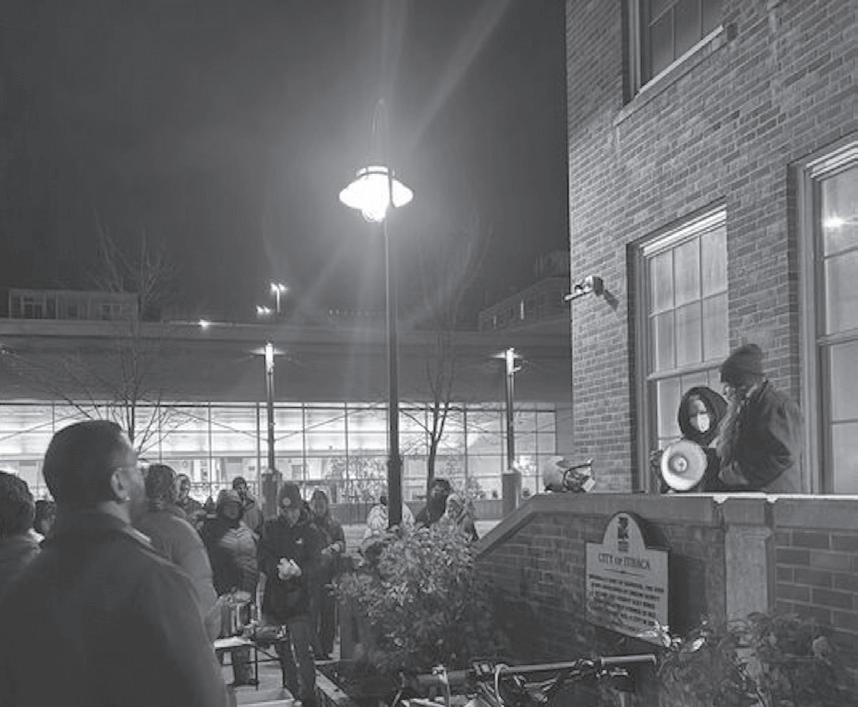
on the sidewalks.
Among the speakers was Angel DeVivo, a member of the ITU, who expressed concerns over the notice of unauthorized camping issued at the bus stop.
“This warning is IPD threatening, implicitly or explicitly, a sweep,” DeVivo said.
DeVivo also criticized the city and the county for failing to provide an adequate homeless shelter.
“The county has the power to direct the [Tompkins County Department of Social Services] and provide low-barrier shelter, but they expect the city to do their dirty work, cleaning up homeless people and sending IPD to where people are sleeping,” DeVivo said.
A plan for Tompkins County and the city of Ithaca to build a joint homelessness service center and Code Blue shelter on Elmira Road fell apart due to soaring costs and operational concerns. Instead, the county plans to open a Code Blue shelter at 227 Cherry St. on Nov. 24.
Code Blue is a state-mandated program that requires counties to offer shelter to anyone who requests it on nights when temperatures remain below freezing for two hours.
Due to the lack of a Code Blue shelter, local organizations started a community warming center in the First Baptist Church on Code Blue nights.
Catherine Stone, another speaker at the rally, expressed frustration with the city and county’s slow progress in providing a Code Blue shelter in time for the cold weather.
“Where is their sense of urgency? Our leaders know that we live in upstate New York. They know how brutal our winter can be. So why was this not a priority to the city or [the] county?” Stone said. “[This] is a life or death situation. People die in these streets and conditions, as someone did just last year.”
In December 2024, Roland Hoyt, a Tompkins County native who had been experiencing homelessness for a few years, died due to exposure to the cold.
Currently, the TCDSS provides emergency housing on Code Blue nights, but DeVivo emphasized the inaccessibility and unsustainable nature of accessing these services.
To continue reading this article, please visit www.cornellsun.com.
the Zoning Advisory Committee.”
If passed, the moratorium would freeze large-scale land use for a year while the town updates the zoning code. The Nov. 5 meeting was attended by those who both support and oppose the moratorium, spurring lively engagement from attendees.
Wetmore said at the Nov. 5 meeting that the moratorium is not meant to single out TeraWulf but to serve as a precautionary measure for the town’s future development.
“[The moratorium] lets us focus on how we want the community to develop instead of what’s coming before us right now,” Wetmore said. “It’s not what’s going on right now, but where do we want our community to be in five or ten years?”
Groff declined to comment and Wetmore did not immediately respond to The Sun’s request for comment.
Environmental Concerns Over Cayuga Lake
Environmental and economic impacts have become the central discussion point in the debate of whether the data center should be built, since the plans for the project were proposed in 2019, after the closure of the Milliken Power Plant.
Assemblymember Anna Kelles (D-125th District), a vocal opponent of the plant, expressed concern that the facility’s cooling system would draw water from Cayuga Lake, “both a drinking-water source and the ecological and economic heart of the region,” she wrote in a letter published in the Ithaca Times.
To continue reading this article, please visit www.cornellsun. com.
Valencia Massaro can be reached at vrm46@cornell.edu.
Nov. 14 — The 130 East Seneca St. bus station, which several unhoused people used for shelter, was cleared by Ithaca Police Department officers on Tuesday evening, according to Daniel Creamer, a volunteer for Ithaca Food Not Bombs.
During the clearing, personal items were removed from the bus stop, and Tompkins Consolidated Area Transit cleaned up the area, according to Deputy City Manager Dominick Recckio.
The city received several complaints about access to the bus stop being restricted due to campers and their belongings, and the people taking shelter at the bus stop were asked to vacate by IPD officers on Tuesday, according to Recckio.
The clearing of the bus stop was “an enforcement action taken by the City pursuant to our pilot administrative policy on managing homeless encampments on City owned land,” Recckio wrote in a statement to The Sun.
Recckio added that local outreach workers enacted several days of outreach to the unhoused people before clearing the bus stop, offering them access to the Code Blue shelter and informing them of the city’s policy.
To continue reading this article, please visit www.cornellsun.com.
Shubha Gautam can be reached at sgautam@cornellsun.com.


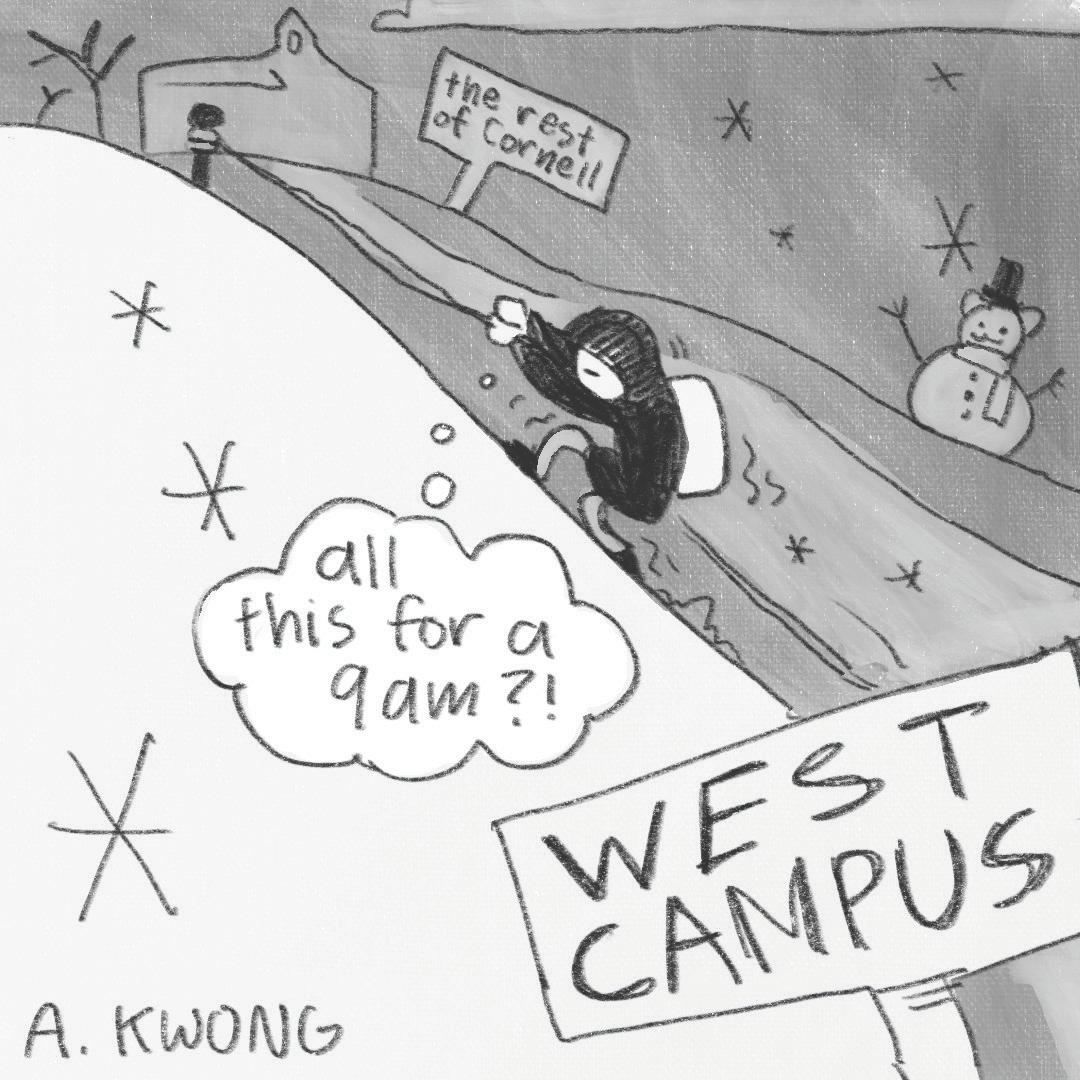


By ROWAN WALLIN Sun Senior Writer
Nov. 15 — Actor Giancarlo Esposito — celebrated for his roles in Breaking Bad, Better Call Saul, The Mandalorian and multiple Spike Lee films — addressed a nearly packed Bailey Hall crowd on Friday night, offering an evening of humor, vivid storytelling and candid insights on identity.
The event was hosted by Cornell University Programming Board and the Multicultural Community-Fueled Activities Board. It received 1,566 registrations on CampusGroups, including both ticket-holders and people on the waitlist. With the balcony of Bailey Hall closed, the crowd that gathered to see Esposito filled the vast majority of the auditorium.
“To be in a mixed-race body and culture and blood and feeling means for me to embrace both — it’s extremely important .”
Giancarlo Esposito
Esposito, whose career spans decades across stage, television, and film, spent much of the conversation — moderated by graduate student Ali Azim — reflecting on his personal journey that
shaped him as an artist. Describing his upbringing as the child of an Italian father and African American mother, Esposito emphasized how early experiences of being placed in “boxes” shaped both his creative life and his understanding of identity.
“To be in a mixed-race body and culture and blood and feeling means for me to embrace both — it’s extremely important,” Esposito said, calling his path toward self-acceptance a long process of “grow[ing] beyond that shame” and becoming “proud of who I am.”
Throughout the night, Esposito encouraged attendees to investigate who they really are rather than who or what the world tells them to be. “You’re not who you think you are, and you’re not who you are told that you are,” he said.
Esposito also spoke about fighting for creative autonomy in the entertainment industry. He recounted years of pushing casting directors to let him audition for roles not originally written for Black or mixed-race actors, and advised attendees to trust their instincts when pursuing their goals.
“Bank on yourself,” he said. “Even if your brain is telling you it’s [impossible]… if your heart tells you that is something you can bring to fruition, you have to go after it.”
During the chat, Esposito recounted stories about working with Emmy-award-winning film director Spike Lee on movies such as School Daze and Mo’ Better Blues and described how, early in his career, he learned a Spanish accent because people frequently assumed he was Spanish based on his name, despite his Italian heritage.
Still, Esposito repeatedly returned to one central message: authenticity. “Be true to yourself,” he told the audience. “It takes courage, especially in this day and age, to be true to yourself.”
Attendees described the evening as unexpectedly moving. Jacob Palmer, a second-year Law School student, said Esposito’s reflections on silence and presence stood out most.
“I really picked up on when he was talking about how he uses silence to bring more meaning to his words,” Palmer said. “It made me think about how we can bring more meaning to the words we’re saying by incorporating a bit of silence.”
Palmer also appreciated Esposito’s early stories about being typecast. “He grew up overseas and overcame this sort of typecasting … he really stuck through to what he thought was important,” he said.
Andrew Day ’28, who knew Esposito from his role as Buggin’
Out in Do the Right Thing, said the talk revealed a deeper, more vulnerable side of the actor, who usually portrays evil, witty villains like Gustavo Fring in Breaking Bad.
“He got a little bit deeper than you would have gotten from just a regular interview,” Day said, calling the discussion of identity and early-career challenges “something a lot of people need to hear.”
For Ava Farkash ’27, the event felt less like a celebrity Q&A and more like an affirming message. “Hoenstly, I feel like he could be a motivational speaker,” she said. “The main thing I took away was to keep being who I am and listen to what I want… I feel like I can walk away with a new mindset.”
“He grew up oversees and overcame this sort of typecasting...he really stuck through to what he thought was important.”
Jacob Palmer
As the evening concluded, Esposito urged students to choose paths aligned with their passions, callings and interests. “Choose what you love,” he said. “You’ll never work a day in your life.”
Rowan Wallin can be reached at rwallin@ cornellsun.com.
By NORA KENZI Sun Sports Staff Writer
Nov. 17 — In a sport where performance is dictated heavily by the conditions and every competition is a new challenge, an undefeated season is a rare sight — but for Cornell’s men’s rugby team, this unbeatable status has been something they’ve fought for throughout this year’s season.
With eight games played and eight games won, this team has seen unprecedented successes, scoring 404 points across the season and proving themselves to be an elite collegiate rugby team across the nation. While the squad has secured the Liberty League Trophy, this is just the beginning for them, as they are looking forward to moving on to the playoffs for the National Championship, starting off on Nov. 21 in which they play against Indiana University and Pennsylvania, the current No. 1 seed and defending national champions.
At the start of the season, hopes were high and energy was higher, and with a roster of many younger players, it was hard to predict what would happen throughout the season.
“We didn’t really know what the competition was going to be like but once we started the season, we got a pretty good idea that we were going to be good, but at the beginning, we were a bit uncertain,” said senior Co-Captain Flynn Kelleher.
Recruiting players is off the table in club rugby, making it hard to predict which players will end up at what schools. This makes the competition between teams hard to predict until the season kicks off. Yet, through this uncertainty, the team knew that foundationally, they were ready to work hard.
“We knew whatever happened that this team was going to have a lot of passion, discipline and resilience and so we felt positive, even though we didn’t know exactly what to expect,” said senior Co-Captain Mylo Skolnick.
In past seasons, the team struggled to keep up with the shifting dynamics of the team with players graduating and new players joining.Two years ago, the structure solidified, mostly due to the implementation of strong leadership and skilled coaches. The team onboarded coaches Max Madziva and Dave Burke who’ve had national and international playing and coaching experience.
“They’ve really helped transition the practices into more what you’d expect from a varsity sport, which has also increased the team’s commitment to the sport,” Kelleher said.
Additionally, they highlighted the importance of the squads commitment to being a player-led team. With many high level players who have experience in competing in international events as well as players who’ve played in
professional academies, having a strong level of tactical understanding from the players allowed for significant involvement in the creation of game strategy as well as quick decision making on the field. With these shifts, the conditions were primed for the squad to have a fantastic season.
Through all this, there was a single moment where the team knew they were destined for a strong season.
During their first game against Binghamton, Kelleher detailed how the team travelled with 17 players and when they arrived to the match, they realized the opposing team had over double the players they had — enough for an A and B team. After about 30 minutes of playing with only 14 players, one player less than usual, they realized that even with a smaller roster, the strength, passion and dedication their players had to the sport was unparalleled.
After a full 80 minutes of competition, they dominated the match and ended up with a 50-0 score, a defining moment of the season that showed them that an undefeated season was in the cards for them.
“So many players stepped up and so many freshmen pulled their weight and I think that was when we knew that this was going to be a very strong season for us,” Skolnick said.
Although it’s been an incredible season for the Red’s men’s rugby
team, there were times where the pressure was on. A major game that was highlighted as the most challenging of the season was the division final on Saturday Nov. 8, against Rensselaer Polytechnic Institute.
“This was the first game we felt real pressure, there was something to lose,” Skolnick said. “We had beaten RPI before but this game was to wrap up an undefeated season and take home a trophy which, for us, was extremely meaningful because this was the first time we were ever going to do this.”
Regardless of the pressure and through the mental strain of needing a flawless performance to take home the trophy, the team persevered and won 33-8, securing their reputations as the Liberty League Champions.
Over the past few years, the team has been through a lot yet has come out on top, using creativity and dedication to create solutions instead of relying on excuses. They have continued to use their passion to give their all in each competition, a pattern they hope to continue through the upcoming National Championship circuit.
“At the end of the day, we aren’t beating teams because we have better chemistry, but it’s because the guys who are on the field, they play with a ton of passion,” Skolnick said.
Nora Kenzi can be reached at nmk55@ cornell.edu.
By SOFIA LOAYZA Sun Senior Writer
While Fishman tells himself that he is bound to find a job as a Cornell graduate. When searching, he began to question that assumption.
“Cornell is such a great school that everyone gets hired eventually … at least that’s what I tell myself,” he said. And yet, Fishman finds himself wondering, “Was it really worth it?”
Rising Unemployment Rates
Fishman’s frustration echoes a growing national trend among college graduates.
The U.S. unemployment rate for recent college graduates rose from 4.3 percent in June 2023 to 4.6 percent in June 2024 and to 4.8 percent in June 2025, according to the U.S. Census Bureau and U.S. Bureau of Labor Statistics. Additionally, unemployment rates for recent college graduates have been consistently higher than the average unemployment rate of all workers aged 16 to 65 since January 2021.
The University’s data mirrors this national trend. According to the Cornell Student Outcomes website, 88 percent of the Class of 2024, for all degree levels, reported being employed or in graduate school within six months of graduation. This is a decrease of 5.5 percentage points from the reported 93 percent of the Class of 2023 who were employed or in graduate school within six months of graduation, according to the Career Services 2023-2024 Annual Report.
Prof. Evan Riehl, economics, said that national data reflect structural shifts in the labor market.
“The share of the long-term unemployed who are college graduates is … growing,” Riehl said. “So it seems like something is changing.”
One likely explanation is technological displacement, says Riehl.
According to reporting by The New York Times, the rise of artificial intelligence has created a misalignment between the skills employers demand and the skills workers possess. This technological shift is now affecting white-collar workers, including college graduates, by automating tasks that previously required a college education, Riehl explained.
“For college graduates, traditionally, they have good employment prospects because they’re knowledge workers,” Riehl said. “But of course, with the recent advances in AI … a lot of those skills are now possible to do with technology.”
According to Riehl, the most dramatic recent change has been in computer science.
“It’s kind of ironic, because what AI is particularly good at is coding,” Riehl said. “So you could potentially be
really is working.”
After unsuccessful online applications, Fishman decided to pitch himself in person. He described going to hotels around New York City to drop off physical copies of his resume to potential employers.
“I did a little elevator pitch. ‘Hi, I’m Jake. I just graduated from Cornell’s Hotel School. I have several years of hospitality experience, and I’m really interested in working at your hotel,’” Fishman said.
Even this more personal approach yielded little improvement, with only one hotel responding.
Navigating the job market led Fishman to reconsider the real value of a prestigious degree.
“Honestly, I feel like the Cornell name definitely is helpful, but I thought it would be stronger than the way it’s been,” Fishman said.
Riehl, however, emphasized that Cornell’s reputation will likely continue to hold weight.
“Employers are often receiving hundreds of applications, so you need some way to get your resume pulled out of the stack, and a Cornell degree is one thing that can help with that,” Riehl said. “Cornell students will still do well, but the labor market they’re entering is fundamentally different than even five years ago.”
“The share of long-term unemployed who are college graduates is ... growing. So it seems like something is changing.”
Prof. Evan Riehl, economics
Despite nearly a year of job hunting, Fishman continued to apply for new positions.
“Applying for a job is a full-time job,” Fishman said. “Every day [I] wake up and apply to jobs [and I hope] something new is posted.”
Fishman’s nearly year-long job search has finally paid off — in an update shared after his interview with The Sun, Fishman says he has since accepted a job as a travel and lifestyle member services associate at Atlas.
The role came through networking, a pathway Riehl said remains a key factor in today’s job market.
“There’s a lot of research in economics showing that a lot of hiring is done through referrals and networking,” Riehl said. “Part of the value that students get from going to places like Cornell is getting tapped into that alumni network, and that will continue to have value for many years to come.”
Fishman said that turned out to be
when Trump was inaugurated and announced the federal hiring freeze, they closed the job completely.”
After the federal hiring freeze, LaGressa pivoted and began applying to city government jobs, nonprofits and private organizations. As of this fall, LaGressa says she has applied to nearly 80 jobs spanning many sectors.
Widespread government cuts have pitted entry-level applicants like her against long-serving government workers now seeking the same positions, according to LaGressa.
“Entry-level jobs are being taken by people who have years and years of experience, because they have that knowledge, they have that expertise and they’re willing to take the pay cut to be able to support themselves and their family,” LaGressa said. “I don’t really stand a chance next to someone who has 10 plus years of experience.”
LaGressa began applying to jobs in January 2025 as she approached graduation. She recalled her first semester at Cornell and said that the highlight of the M.P.A. program at the time was that 90 percent of M.P.A. graduates graduate with a job.
“So I [thought], ‘I’m going to graduate [from] this program with a job.’” LaGressa said. “I thought that the effort [I’ve been] putting in … would be enough for me to have a job.”
The federal hiring freeze and cascading layoffs changed that reality for graduates like LaGressa, who hoped to enter the government and policy field.
LaGressa said she has repeatedly reset her job-search strategy — from mass applying to jobs, to networking, meeting alumni, building a website and publishing LinkedIn articles — but has heard back from only about a fourth of the positions she applied to.
“You feel like you’re living [in] Groundhog Day,” LaGressa said. “[Every day] I’m getting up … and I’m just searching for jobs for five hours. Or I’m writing another cover letter … you have to keep going and switching it up so you don’t fall into a depression of not
“Despite being unemployed, I’m somehow busier than ever. Basically, applying for a job is a fulltime job.”
Jake Fishman ’25

A move home helped ease some of the financial pressure, LaGressa said, but she still has bills to cover while balancing two part-time jobs with her concurrent job search.
“Working these jobs at the same time as I’m trying to apply to jobs and trying to network is proving difficult,” LaGressa said. “I put in so much work to get to where I am today, and I feel like I want my salary, my benefits to show for that, and I also want to work in an organization that I actually care about.”
LaGressa seeks a role that matches the effort she has invested in her education. However, the constant pressure to find a job has taken an emotional toll.
“It took a lot for me to get here to Cornell,” LaGressa said. “It took a lot of money to pay for this degree, and I feel like I’m almost letting my family down by not … having a job and showing that my education was worth it.”
A Different Path: Balancing Two Jobs After Graduation
Miguel Barrera ’24 has taken a different path to employment, one that he did not anticipate. Barrera studied plant science and worked as an undergraduate research assistant during all four years of college. He imagined he would pursue a Ph.D. after graduating.
Ultimately, when the plant science programs he had been accepted into weren’t his first choice, Barrera decided that he wanted to try again the following year.
He then found temporary lab work, then full-time employment in Ithaca, where he has remained since graduation.
To continue reading, please visit www. cornellsun.com.
Sofa Loayza can be reached at sloayza@ cornellsun.com.

Do stereotypes always go too far? Or are they, in some ways, what give a comedy its spark? These questions came to me as everyone’s favorite bingeable show, Nobody Wants This, returned for season two. We are brought back into the turbulent relationship of Rabbi Noah Roklov (Adam Brody) and Joanne Williams (Kristen Bell), a typical LA non-Jewish girl repeatedly labeled a “shiksa.” As in season one, the central conflict revolves around Joanne’s conversion process and what it means for her future with Noah.
Reviews of Nobody Wants This season two are mixed. In my opinion, one of its major improvements is the step away from a lot of the blatant stereotypes that dominated season one. Esther Rocklov, for example, was far more likeable, given more of a personality and had less of the persona as a frigid and vindictive wife. Her newfound depth paints her in a much better light. The season’s numerous scenes featuring her deeper relationship with Sasha are some of the season’s most endearing moments. The moment in episode four with Sasha on Valentine’s Day at their dance class in which she jumps for joy straight into his arms was especially heartwarming.
The season avoids many of the uncom-
fortable attempts at comedic antisemitism from season one. Moments such as, in season one, when Morgan tells Joanne that Noah looks cute and “doesn’t look Jewish,” are clearly intended as a joke, but come across rather offputting. This raises the broader question: at what point do stereotypes stop being funny and start feeling harmful?
To its credit, season two takes a more thoughtful approach to depicting Judaism. Instead of simply poking fun at Jewish tropes, it digs into genuine questions about what it means to be Jewish and how interfaith relationships complicate identity. Rather than waffling about the convenience or inconvenience of going through the conversion process, Joanne truly wants to feel the spirit of Judaism before deciding to go through the conversion process. Her deep inner debate was further emphasized through contrast with her mother’s own spiritual realization, and Joanne’s continued feeling that she was lacking that deeper connection. I was honestly impressed by Joanne’s commitment to the process, which is one major way that her character was expanded in season two beyond just a caricature of a “shiksa.”
Yet with all these improvements, I couldn’t shake the feeling that season two lacked some of the charm that made season one so addictive. Don’t get me wrong, I still thoroughly enjoyed my watching experience; I finished the whole thing in two days. However, I couldn’t
help but feel a bit unfulfilled and frustrated by the end.
For one, after spending the entire season delving into the issues of Joanne’s and Noah’s relationship, the writers resolved everything in the final minutes with the very same revelations that ended season one. In the beginning of season two, their relationship seemed somewhat too perfect. They were in the honeymoon phase some might say, cooking together, hosting their first dinner party, etc. As more and more issues began to arise, it seemed to me the couple would need to take a serious look at their relationship, or it would have to end. In no way did I expect Joanne to have a sudden spiritual revelation, and for Noah to instantaneously realize that nothing mattered except his relationship with Joanne (yet again). Their issues are swept aside once more with the message that “love conquers all,” a conclusion that feels overly neat, if not outright naïve.
Ultimately, the season raises a larger creative question: does removing stereotypes make a show better, or does it dilute some of its comedic appeal? Yes, there were plenty of alarming instances when a moment of comedy may have crossed over into antisemitism in season one, but there were also flashes of comedic brilliance inspired by those very stereotypical characters. While many viewers criticized season one of Nobody Wants This for perpetuating cruel stereotypes, I cannot help but feel the show lost a
piece of its humor with such a drastic shift. To be clear, I do not believe in the promotion of harmful stereotypes, but as a Jewish woman myself, lighter moments of relatable comedy present in season one added to its charm, and I found that aspect lacking in season two. So as to the question of whether stereotypes harm a show or contribute to its comedic appeal, I would say there is virtue to both. It is clear that Nobody Wants This season two attempted to strike a balance. I believe the season’s more cautious approach ultimately trades some of the show’s distinct comedic sharpness for a safer, more universally palatable tone, an exchange that will resonate differently with each viewer.

The trend of Gothic adaptations in film this decade has allowed some of cinema’s most interesting filmmakers to finally tell their favorite stories in their own voices. This year, Guillermo del Toro’s Frankenstein feels like a match between director and story as fitting as Robert Eggers and Nosferatu , and the weight of del Toro receiving the budget and freedom to tell a story so important to him is felt throughout the film. Frankenstein is a massive film in both scale and scope, and while some moments feel a little messy, the end result is an impressively beautiful story of pain and forgiveness.
Frankenstein is an adaptation of Mary Shelley’s 1818 novel and follows the same story-within-a-story framing. During a journey to the North Pole, Royal Navy Captain Anderson encounters a wounded man, stranded on the ice, who is being pursued by an inhuman creature. This is Oscar Issac’s Victor Frankenstein, a scientist whose lofty ambition led to his own downfall. Victor tells his tale to the captain in hopes of dissuading Anderson from continuing his own ambitious journey of plotting a new route to the North Pole. Bound together by their dreams of grandeur, Captain Anderson listens as Victor recounts the experiment that led to his doom, and that the creature now standing outside their boat was created by Victor himself.
Frankenstein might disappoint
book purists hoping for a completely accurate adaptation. Guillermo del Toro uses the story of Frankenstein to explore his own relationship with parenthood. Victor’s backstory is altered to tell a deeply personal story of generational trauma and the cycle of violence passed down through families. Here, it is not the grotesque nature of the Creature’s existence that disturbs Victor, but the responsibility suddenly thrust upon him to nurture a child when he himself received little love from his father. Victor passes on his anger, grief and desire for vengeance onto the Creature, but is then unable to comprehend his role in making his creation what he is. Victor treats the Creature the same way his father treated him, but is shocked and disturbed when the Creature turns out much like Victor.
While these changes are extremely effective in the overall narrative, they do make the film’s first hour a little slow. Victor’s college life and friendship with Henry Clerval are traded for a relationship with a rich benefactor, Henrich Harlander (Christoph Waltz), who funds Victor’s experiments. The first part of the film, before the Creature is made, drags a little more than it does in the novel. However, the introduction of Harlander also introduces Guillermo del Toro’s version of Elizabeth, the woman that Victor forms an obsessive attachment to. Mia Goth’s Elizabeth is Harlander’s niece and the fiancé of Victor’s brother William, creating
an interesting dynamic. In the novel, Elizabeth is taken into Victor’s family at a young age and is promised to him since childhood. There, Victor sees Elizabeth as an object belonging to him, something he will possess once he has finished his experiments. In the film, Elizabeth becomes entirely unattainable. Her engagement to William, as well as her own indifference to Victor, make Victor’s obsession with her all the more delusional.
It’s after this first hour that the film truly finds its footing. Frankenstein becomes truly great when Victor’s experiment ends and the Creature (Jacob Elordi) is born. Jacob Elordi’s performance, despite the layers of prosthetic makeup he wears, is the best of the year. Despite his huge stature, Elordi’s Creature feels incredibly gentle. His eyes do most of the storytelling, at times portraying the wideeyed innocence of a newborn, at others the sadness and grief of an abandoned child, and, later, the unrelenting rage of a monster. The Creature sends Victor’s life into turmoil, especially when Elizabeth forms an instant connection with him. The relationship between Creature and creator is that of a father and son, yes, but it also grows deeper when Victor begins to feel like the Creature has taken everything from him — especially the love of Elizabeth. The dynamic between Victor and his creation is incredibly fascinating and, while successfully adapting the major themes from the novel, adds another, more familial layer to their relation -
ship. Once the Creature joins the story, Frankenstein becomes exactly the movie I wanted it to be.
While Frankenstein may not be perfect, it’s still cemented itself as my favorite film of the year. Jacob Elordi’s performance as the Creature elevates a film of beautiful, grand visuals into something much more human. Its only setback is its limited theatrical run — Frankenstein is already available to stream on Netflix, but it is certainly made to be seen on the big screen. I encourage viewers to make every effort to see it in theatres before watching it on Netflix.
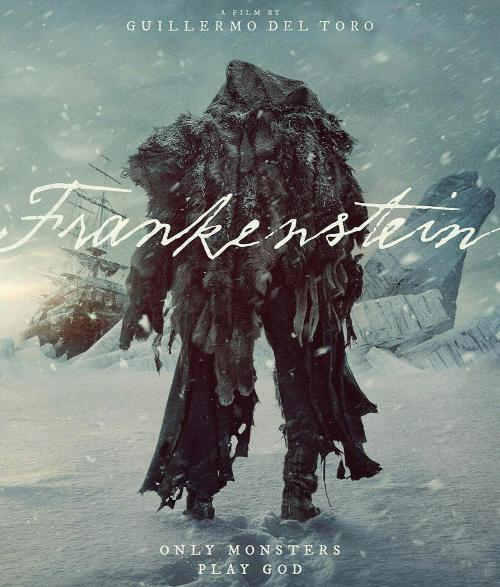
‘Projections’ is a column focused on reviewing recent film releases.
By MIKAYLA TETTEH-MARTEY Arts & Culture Contributor
There’s something about the night that stretches time, turning ordinary streets into endless ribbons of light. Shadows dance on the asphalt, the air hums with possibility and the road pulls you into a world where you feel both untethered and alive. These songs are perfect companions for a late-night drive, when the city feels like it exists just for you.
1. Tame Impala: “Let It Happen”
The opening swell of this song feels like slowly turning up the dial in your car, and the looping synth pulls you into that spaced-out haze where everything blurs just a little. By the time the glitchy undertone creeps in, you honestly can’t tell how long you’ve been driving (though, obviously, stay focused on the road). It’s one of those songs that turns the road into a place to think rather than a place to be.
2. Khalid, Ari Lennox, Smino: “Scenic Drive”
I mean, it says so right in the title — this song is the perfect soundtrack for a late night drive, windows down, wind tangling through your hair. Smooth and reflective, it carries a cinematic weight, like you’ve stepped into a scene made just for you.
3. Frank Ocean: “Pyramids”
This song genuinely feels like a drive that never ends, in the best way possible, and not just because it’s almost ten minutes long. The hypnotic beat switch halfway through is like turning off the 405’s gridlock onto an empty backroad, where the dashboard glow suddenly feels brighter and you become hyper-aware of everything around you. “Pyramids” is honestly too long to be practical but way too good to skip, turning the soundtrack of your life into something far more cinematic than it probably is.
4. PARTYNEXTDOOR: “Dreamin”
OK, picture one hand on the wheel, the other out the window. This is what this song encapsulates. It has that slowburn, hypnotic pull that makes every moment feel suspended, like the night itself is stretching out just for you.

5. Don Toliver: “No Pole”
This song feels like drifting through the night with no real destination. The airy production, wrapped around Toliver’s unique vocals, makes everything blur together, yet even the emptiest roads pulse with a quiet energy, like the night itself is alive.
6. Don Toliver: “Can’t Feel My Legs”
This song makes every drive feel faster. The floating melodies, tied together with the quick drum beat and bass that makes it feel like the car is humming along with you, make it perfect for cruising. It’s the ideal part of the drive when everything outside turns into a streak of color.
7. Swedish House Mafia, The Weeknd: “Moth to a Flame”
This is a neon-lit kind of song. Something about it makes every streetlight feel sharper, more dramatic. The low bass keeps you grounded. The production is icy, a little dangerous.
It’s perfect for those moments when you just want to look straight ahead and avoid every problem in your life.
8. The Weeknd: “House of Balloons/ Glass Table Girls”
Another The Weeknd song, obviously. It’s chaotic, restless and a little haunting. Maybe not one to relate to, but that doesn’t make it any less captivating. It feels like being awake in the dead of night, noticing the air sharper than usual. The chorus hits like yelling into a pit of darkness, only to have the echo come back twisted and strange.
9. PARTYNEXTDOOR: “MakeItToTheMorning”
A survival song at its finest, disguised as a smooth, late-night anthem. It pairs beautifully with the surreal calm of 2 a.m., when the roads are empty and you’re aware of how tired you actually are but don’t want to admit it. The song feels like a quiet bargain with the universe: “let’s make it to the mornin’.”
10. Childish Gambino: “Les”
This song will genuinely hit you hard, like the pulse of the city at night. “Les” has one of my favorite instrumentals, smooth, reflective and a little raw. It’s a song that turns empty streets into a moving canvas, where every sound feels alive and the night stretches on forever.
11. The Neighbourhood: “The Beach”
Honestly, the perfect song to close out a long night drive, the final stretch. The vocals and beat pull you in, carrying that space between wakefulness and thought, where you’re neither sad nor fully present. It’s the sonic version of a sigh slipping out, the kind you didn’t even realize you’d been holding through the whole night.
‘Solar Flare’ is a weekly playlist column where Sun contributors spotlight a slice of musical taste with the campus community. It runs every Monday.
Mikayla Tetteh-Martey is a junior in the College of Agriculture and Life Sciences. She can be reached at mkt62@cornell.edu.
By TOMMY WELCH Arts & Culture Contributor
Nuremberg hit theaters Nov. 7 and has made a bit of a splash. It’s generating an interesting discussion around the depiction of evil, its intentional parallels to the modern era (i.e. the Trump administration) and representational responsibility — on the edge of being controversial. Whether you find its thematic treatment thoughtful or irresponsible, the 95 percent audience score and 70 percent critic score on Rotten Tomatoes is a testament to, if nothing else, the solid execution of the film.
Nuremberg is a historical courtroom drama that traces the relationship between psychiatrist Douglas Kelley (Rami Malek) and Hitler’s second in command, Hermann Goring (Russell Crowe), as he awaits his trial for war crimes. When Goring arrives, Kelley is assigned essentially as his therapist, the nominal purpose of which being to monitor against the risk of suicide. Kelley develops a great empathy with him, and as he along with the rest of the world learns of the horrors of the concentration camp, we toddle around the question of whether Goring was responsible or even knew of it (which seems ridiculous to us now). Ultimately Kelley arrives at a quandary of whether to maintain his professional vow of privacy or facilitate the conviction of Goring.
Before digging into the heart of the material, the film should be recognized for its technical mastery. Crowe gives a very memorable performance as a charismatic narcissist; he employs a smile unique to this character where it feels almost as if he is entertained by his own cleverness, savoring his own charm. Malek feels naturalistic in his role as a sympathizing psychologist and develops something akin to Stockholm syndrome, ironically enough as Goring sits in the cell. The film looks very good, firm in its choice of sepias and generally low-key side lighting that is sort of what you imagine in your head when you think of a historical drama.
What makes this film radical, separating it from any World War II/Holocaust film I can think of, is its humanization of Goring. One person online described walking out of the theater because they found it so offensive. He is a likeable character and written that way intentionally. Goring is characterized with strong wit, affably confident — “I’m the most fit man in the world. My wife tells me so,” — and as an audience, we are made to perceive him the same way Kelley does. There have been other movies that treat Nazis as complex characters, such as Hans Landa in Inglorious Basterds or Amon Goeth in Schindler’s List, although they are still made to be unredeemable. There have even been movies such as The Pianist where we are presented with one genuinely good-hearted Nazi, the one good apple in a sea of filth. But I can’t think of another film that takes the most culpable figure in the third Reich aside from Hitler and sits him up next to us as if having a genial cup of tea, like he’s Forrest Gump on the bench amiably winning our affection.
The film ultimately isn’t supporting people like Goring, however. With the ending providing a sort of polemic about how people like Goring are not limited to Nazi Germany, and need to be surveilled against even in America, it is attempting to accurately portray evil as an invisible kernel that can’t be discerned easily in things like conversation. This ending attempts to pose a warning about current trends in contemporary America, and many critics have actually expressed frustration with this as overly blunt and half-developed parallel.
There is a particular emphasis on the emigration of Jews, the film zooming in on the word as Goring uses this to argue he did not support the concentration camps. The focus very much feels like an attempted commentary on ICE, and if we continue the parallel, that ICE’s pretense of deportation may well develop into full-fledged extermination through its detention centers. But, as Kelley argues in the film at a different moment, there is a difference between the intentional decimation of German Jewish citizens and US Japanese internment camps, which are
further different from ICE detention centers of non-citizens. And to equate it is arguably disrespectful to the depth of the horror of the Holocaust (not to diminish the dangers and poor living conditions of ICE detention centers). At one point, Goring even says, “Hitler made us feel German again.” The film gives little nudges as if to say, “look, it’s so similar,” without digging into any real policy or substantive argument to delineate exactly where our modern history is falling into the past. It more works to get nods from those who would already agree with the statement rather than earnestly searching for a pattern.
Other critics have called the film “staid,” “plodding” and like a “West Wing Episode.” I have to agree that the film, outside of how it characterizes Goring, is an incredibly typical historical drama. We follow a bunch of ‘talking heads’ over shot-reverse-shots, and receive expository arguments somewhat impersonally from actors used as mouthpieces not so much as characters. It does not challenge in its structure or utilize the visual power of film in the way other movies including those about World War II and the Holocaust have; using the cinematic medium in a uniquely fitting way to address the issue, such as The Zone of Interest, Night and Fog or Schindler’s List. In some ways, it feels close to some made-for-TV historical movies I have seen and of standard biopics or sports movies where the team is down, and then at the vital moment they score the touchdown.
That being said, I came away thinking, “That was a good movie.” It is highly entertaining, especially from the performances, and it gives you a thing or two to think about. It is very solid, perhaps not revolutionary. While the parallel to America is a bit lazily pinned on, the representation of evil feels realistic. Three and a half to four Letterboxd Stars.
Tommy Welch is a senior in the College of Arts and Sciences. He can be reached at tsw62@cornell.edu.
By JANE McNALLY Sun Senior Editor
In a game that lasted over three hours, No. 20 men’s hockey pushed through a lengthy delay to pick up a 5-2 win over Yale and secure a series sweep.
The score was 4-1 Cornell when the second period ended at 8:29 p.m. The puck would not drop for the final frame until 9:31 p.m. due to an issue with the Lynah Rink ice. The Lynah Faithful grew restless as the ice was cut twice by the zamboni and a fire extinguisher was even brought out in an attempt to mitigate the ice issues.
“I’m disappointed in the way it played out there with the ice. We have high standards here. We’ll get that rectified, but I think a lot of things come into play there, with the weather and then the women’s game before us,” said head coach Casey Jones ’90. “But I really appreciate the fans sticking around big time. I thought a large percentage of the crowd hung tough, and that means a lot to us.”
Despite the circumstances, the Red exploded offensively — junior forward Ryan Walsh had two goals and freshman forward Caton Ryan converted once more after his two-goal performance on Friday, with both forwards capping off the weekend with three tallies each.
“Extremely weird game. It’s one of those things that it’s kind of out of your control,” Walsh said. “You try to not let it affect you. But I thought we came out pretty well after the hiatus. It’s always good to get six points and a sweep in the first home weekend.”
Cornell won the special teams battle once
again, going a perfect 3/3 on the penalty kill, while the Bulldogs could only solve one of the Red’s two power plays.
Despite the high-scoring game, the first period was scoreless. Just shy of the halfway point of the first period, senior forward Nick DeSantis made a nifty move at center ice to create a two-on-one, and Ryan was hooked on his way to receive the pass, sending Cornell to the power play.
Cornell mustered up some strong chances — including a rocket off the stick of Walsh that wrung the iron — but could not beat Yale goaltender Jack Stark.
Stark earned the start after surrendering six goals to Dartmouth in the Bulldogs’ first game of the season, not having seen the ice since being pulled after the second period on Nov. 2. Though Yale’s sophomore goaltender Noah Pak had played well as of late, Stark has notoriously shone against the Red — in three previous regular season games versus Cornell, Stark had posted a .902 save percentage, forcing two of those matchups to shootouts.
“They’re a good physical team. They’re always hard to play against, doesn’t matter their rank,” Walsh said.
While the first period was relatively quiet, the second was anything but. Five goals were scored between the two teams, including four in just over six minutes.
First, a one-timer by Walsh off a stellar feed from junior defenseman George Fegaras on the power play broke the stalemate 7:02 in. The tally marked the second-straight game with a power-play goal for the Red.
Yale would retaliate by drawing a penalty of its own, but some solid stops by freshman goaltender Alexis Cournoyer preserved the
Cornell lead.
“We’re trying to extend our bench with multiple guys, new guys killing,” Jones said. “I thought they did a good job this weekend.”
That lead would double when freshman forward Reegan Hiscock buried a rebound past Stark. The goal came not without stellar playmaking from junior forward Jake Kraft, who led the breakout and a nifty give-and-go, eventually creating the rebound that Hiscock jumped on.
Before the Lynah Faithful could finish celebrating the second Cornell goal, Yale’s Ronan O’Donnell redirected a shot in the high slot that beat Cournoyer, halving the Red’s lead just 27 seconds later.
The floodgates for the Red, however, had opened. And while the first two Cornell goals were to no fault of Stark, the next two were ones the netminder would want back.
With 6:30 to play, a strong play by DeSantis — falling to the ice as he fired the puck — culminated in a shot that eked through the fivehole of Stark. A little over three minutes later, Walsh secured his second of the game by managing a loose puck between Stark and the post, a near no-angle play that put the Red up 4-1.
The line of DeSantis, freshman forward Gio DiGiulian and Ryan was noticeable all night and was assembled by Jones to capitalize on their speed.
“I thought was one of [DeSantis’s] better games this year,” Jones said.
Perhaps it was the 62-minute delay that ensued, but Cornell’s momentum was largely halted when the third period finally began. The Bulldogs ate into the Red’s lead and made it 4-2 with a goal 6:03 into the third — a
turnover at Yale’s blue line created a two-onone rush for the Bulldogs, and a ricochet off the defensive stick senior defenseman Jack O’Brien led to David Chen’s backhand poke past Cournoyer.
“I think we could’ve done some things better,” Walsh said when asked about how his team responded after the delay. “I think we need to learn how to play with the lead. We’re a young team, and I think that’ll come, but I thought we handled it all pretty well.”
Cornell’s kill was put to the test almost immediately after, but a strong showing on the PK kept the lead at two goals. Not much later, the Red made it 5-2 when Ryan redirected a sophomore defenseman Michael Fisher shot past Stark, the goal a result of a long shift in the offensive zone.
The score would hold as Cournoyer ended his night with a flurry of saves to cap his total at 27. The freshman netminder finished the weekend with a stellar .947 save percentage en route to a six-point sweep.
“It’s tough to be mad at not managing the game. The third period, [being] in that situation was tough, you know?” Jones said. “But I can’t emphasize it enough — our guys were talking about on the bench [about] the loyalty of the fans to stick around, and all that meant a lot to us.”
Cornell will be back on Lynah Rink ice next weekend as it hosts Union and Rensselaer Polytechnic Institute on Nov. 21 and 22, respectively. Puck drop for both games is slated for 7 p.m.
Jane McNally can be reached at jmcnally@ cornell.edu.
By ALEXIS ROGERS Sun Sports Editors
The last time women’s hockey conceded three goals in a single period was on Jan. 11, 2025, during the second game of its weekend against Colgate.
On Saturday afternoon, history repeated itself. Following a scoreless first period, the Red allowed three goals by No. 14 Colgate, while scoring two, in the second.
No. 4 Cornell sought redemption after falling 3-0 the day before in Hamilton. What it got was a penalty-filled, high-scoring clash that wrecked the Red’s perfect penalty kill and forced it to play catch-up.
Yet, despite its imperfections, Cornell fought back from deficit to push the game into overtime. An avoidable penalty by the Raiders gave the Red a late skater advantage, and when it needed to, the Cornell power play performed.
The Red secured a hard-fought 4-3 overtime victory — even though its only lead was the one it held at final time.
“As much as you hate to lose, I thought [the loss on Friday] was good for us,” said head coach Doug Derraugh ’91. “We hadn’t been behind in any game. Everybody can be in a good mood and be a good teammate when you never face any adversity.”
Cornell (8-1-0, 5-1-0 ECAC) faced plenty of adversity in the first period. The Red spent more time on the penalty kill than at full strength during the first seven minutes of the game.
One minute into the game,
sophomore forward Lindzi Avar received a penalty that gave Colgate (6-7-1, 2-3-1) an early extra-skater advantage. Thanks to a defensive lockdown by Cornell, the Raiders couldn’t manage a single shot on junior goaltender Annelies Bergmann.
Two minutes later, junior defender Piper Grober was sent to the box — this time, Colgate mustered a more coordinated effort, but it wasn’t enough to pierce the Red’s defenses.
As the clock wound down on the first period, Cornell took its third penalty of the game. Tensions grew in the final minutes of the period as the Red fought for opportunities, with play — and interactions after the whistle — becoming more physical.
“You can accept some of those penalties where you’re just being physical and trying to play the body, and maybe it doesn’t go your way,” Derraugh said. “It’s those ones where you get hit and then you try to retaliate, those are the ones that you try to avoid.”
As it had in the first period of Friday’s game, the Red saw low offensive production in the opening 20 minutes, taking 10 shots. This inability to generate chances was augmented by six minutes of shorthanded play, but the Raiders’ eight shots showed the strength of the Cornell penalty kill.
The second period started with high energy — and it only grew from there.
Junior forward Karel Prefontaine broke away less than two minutes into the frame but was tripped
by the sticks of Colgate defenders. Though the opportunity was spoiled, Prefontaine earned a penalty shot, which goaltender Brooke Davis successfully blocked.
Not long after, the Raiders went on the penalty kill for the first time, with two players sent to the box for interference and slashing. Cornell’s power play, which had the best scoring rate in the country before coming up short in four attempts on Friday, battered Davis with shots but came up short in the three-onfive opportunity.
The Raiders quickly clawed back control, and seconds after returning to even strength, Alexa Aubin broke away while the Red was still in attack formation. Aubin shot over Bergmann’s shoulder to put Colgate on the board.
Closely following the goal, Avar took another penalty, again forcing Cornell to the kill. However, when senior forward Avi Adam saw an opportunity to charge the Raiders’ goal, she took it. Adam scored the Red’s first shorthanded goal since Feb. 14, tying the score 1-1.
Despite the goal, the Raiders were still on the power play. Off the ensuing faceoff, Colgate returned to the attack, and Avery Pickering took a low shot from close to the blueline that snuck through Cornell’s defenses, lifting the Raiders back into the lead just 29 seconds after the Red had evened the score.
This was Cornell’s first allowed power play goal of the 2025 season, snapping a 22-penalty-kill streak.
The game’s pace didn’t relent, and before the halfway mark of the period, Cornell was back on the kill.
A deflected Colgate shot bounced in the crease but stayed out of the goal, and the ensuing scuffle resulted in a Colgate penalty, which led to a minute and a half of four-on-four play.
With limited skaters on the ice, Colgate struck fast, beating Cornell’s defenders to the net and potting their third goal of the night.
Seconds past the game’s halfway point, the score sat at 3-1 in favor of the visitors.
From there, penalty chaos ensued. With 2:38 remaining in the period, Colgate took a penalty. At 2:19, a Cornell penalty evened the playing field. At 2:01, the Raiders sent another player to the box — setting up a three-on-four advantage for the Red.
With the clock reading 1:55, Adam scored her second goal of the game and narrowed the deficit to 2-3.
“We had to make adjustments from yesterday because we didn’t capitalize on those [power plays],” Adam said. “Just making small tweaks and making sure we’re opening up different lanes, especially on our power play. … It worked today.”
Due to Colgate’s two-skater penalty, the teams played four-on-four until the final 19 seconds, when Cornell went back on the power play for the remainder of the period. The second 20 minutes were riddled with penalties — three on Cornell and six on Colgate.
After the eventful middle period, the third began relatively calm. After 14 minutes, neither squad had capitalized. The score remained fixed until a Colgate penalty brought
back Cornell’s hunger.
“It was a really good bounce back from yesterday,” Adam said. “It shows how close our team is and how resilient we are. We hadn’t really been tested by a team like that so far this year, so for us to be able to regroup that quickly after a game [like] yesterday shows a lot.”
With just under six minutes remaining in regulation, the Red’s dominant power play made an appearance. Senior defender Grace Dwyer sent three shots Davis’ way before passing over to Grober, who slotted home the game-tying goal.
After the remainder of the third period passed scoreless, the game went into overtime. When Aubin and Dwyer became entangled and fell to the ice, Aubin threw Dwyer’s stick aside and drew an unsportsmanlike conduct call that gave the Red a crucial four-on-three advantage. It would be Prefontaine who broke through, seconds into the power play. With a strong shot past Davis, Prefontaine earned Cornell its first — and final — lead of the game.
“I think I strive in those moments,” Prefontaine said. “I’m someone who plays better when there’s a lot of pressure.”
Cornell didn’t score a single goal over the course of two days while both teams were at full strength.
To continue reading this article, please visit www.cornellsun.com.
Alexis Rogers can be reached at arogers@cornellsun.com.